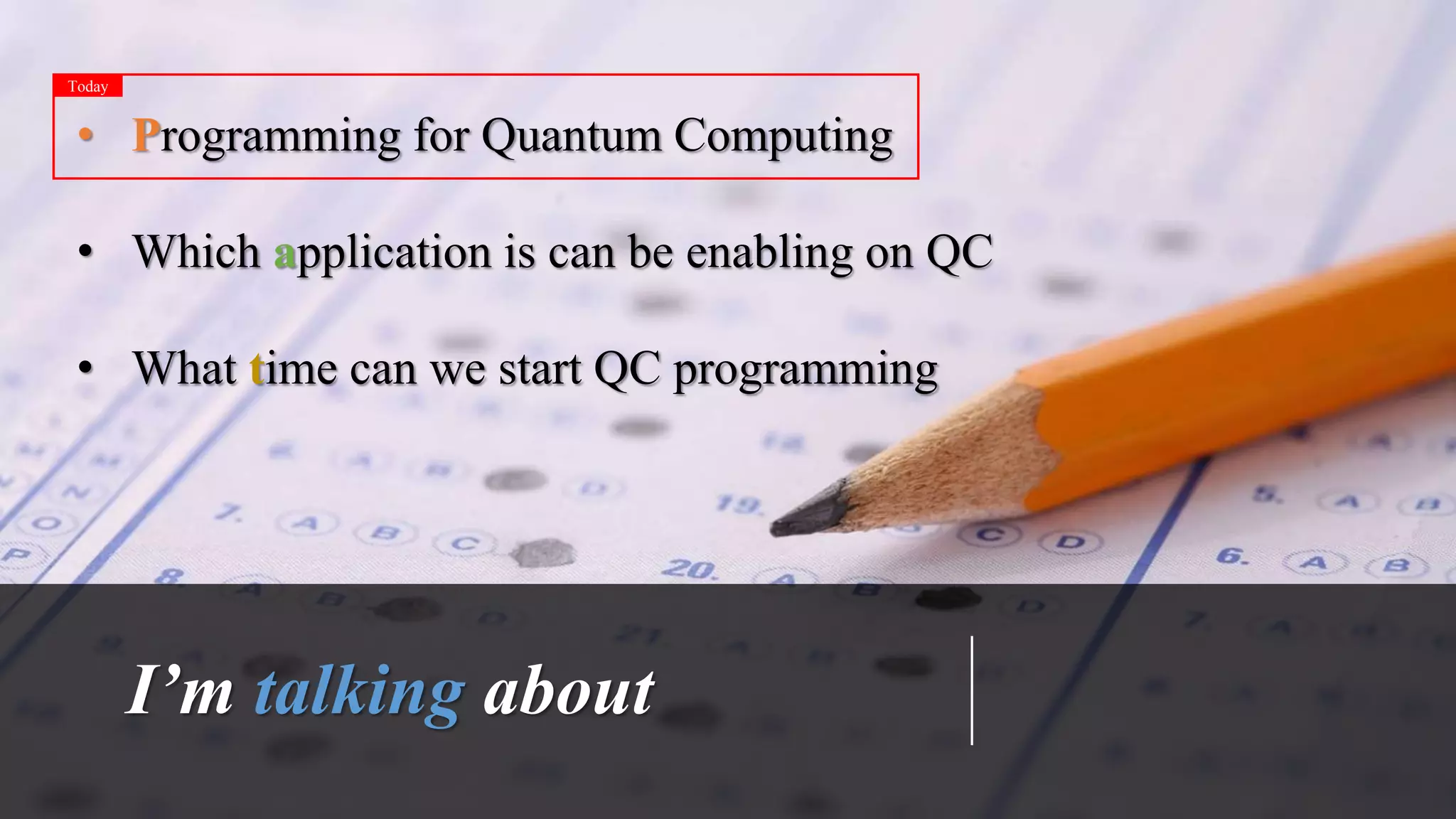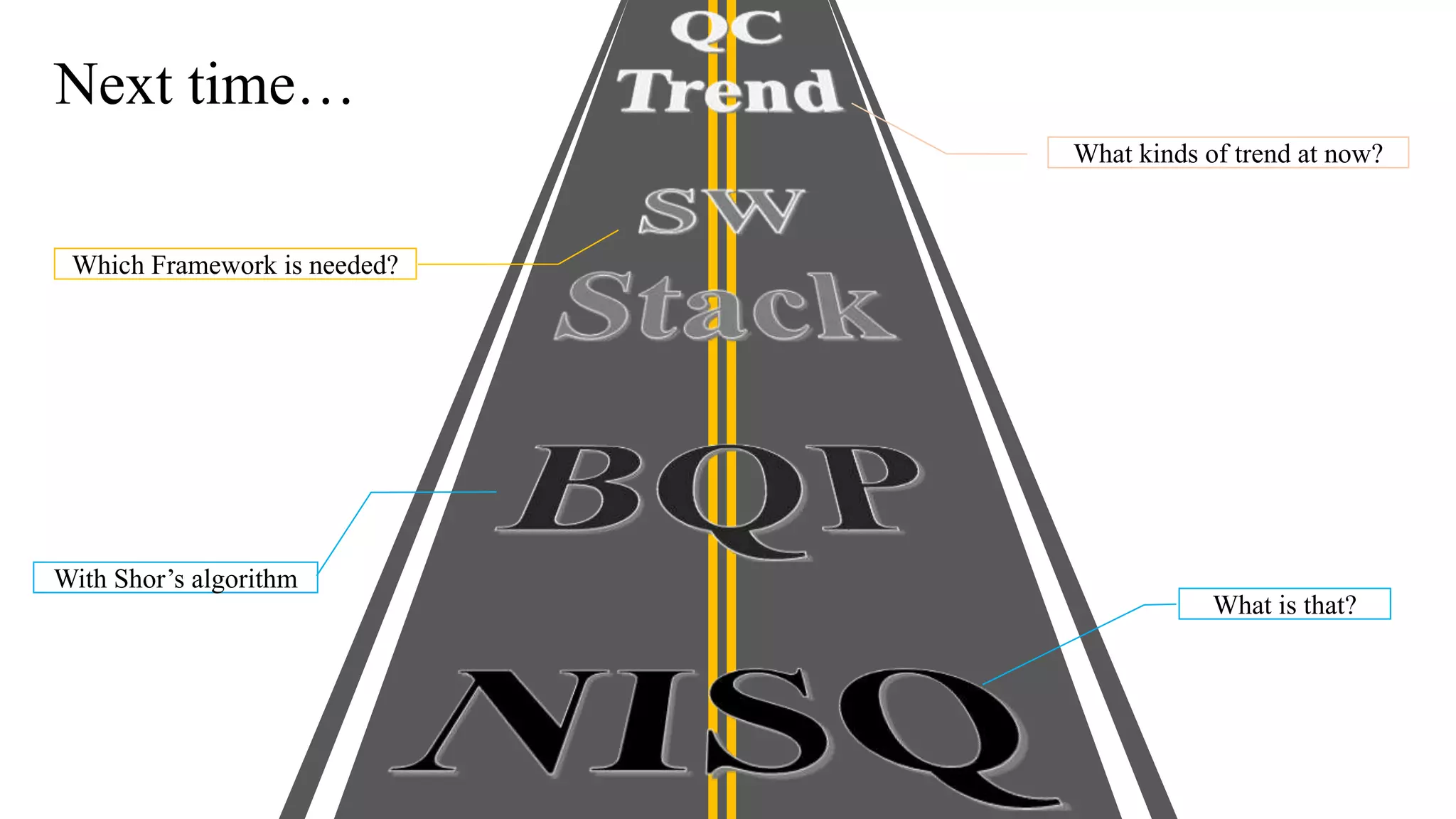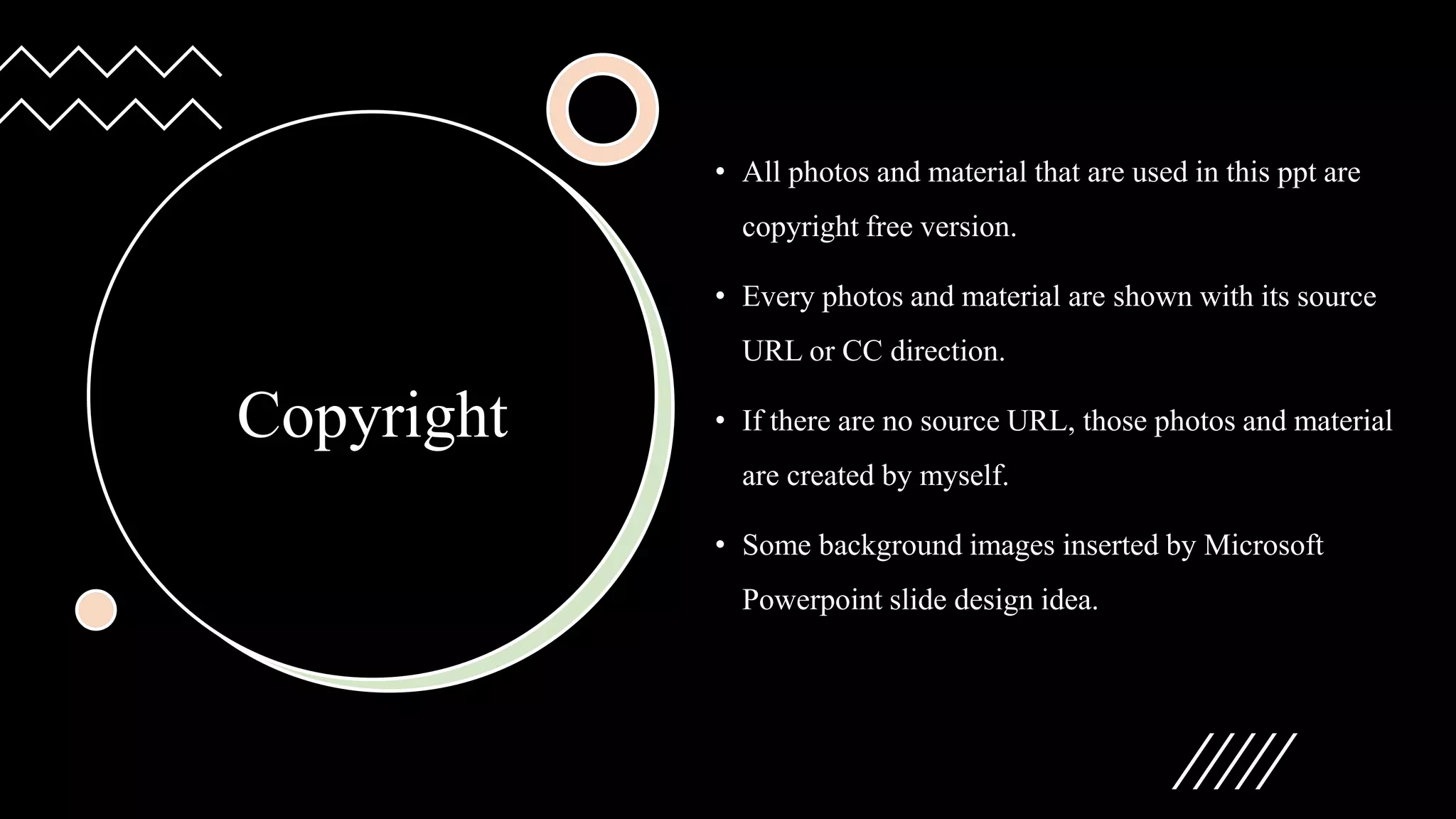The document provides an overview of quantum computing tailored for software engineers, discussing the programming aspects and potential applications of quantum computing. It covers the hardware and software stack comparison between classical and quantum computers, the basics of qubits, and introduces programming with quantum circuits using tools like Qiskit. Additionally, it emphasizes the unique capabilities of quantum computing, such as superposition and the handling of complex data sets.

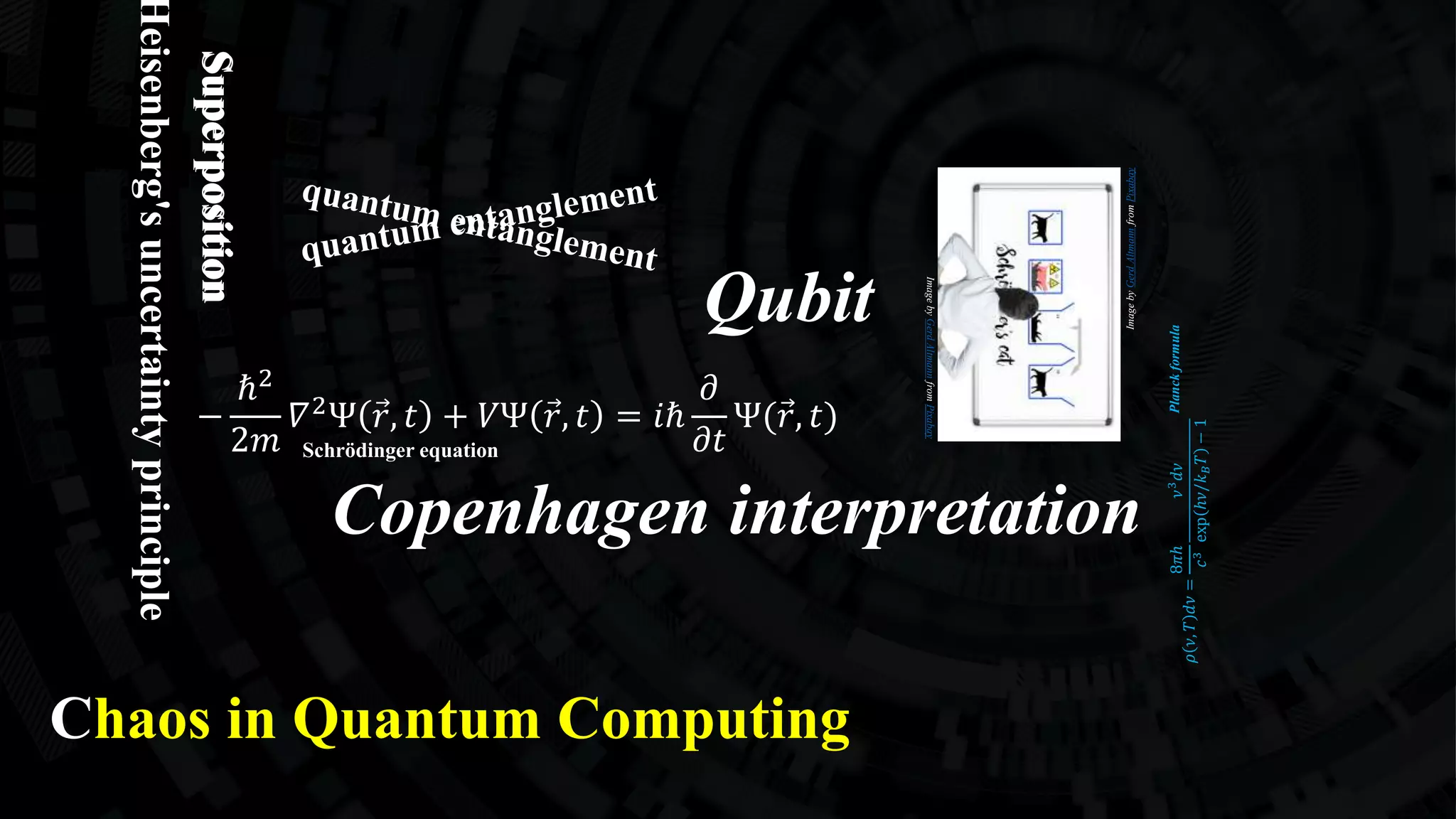

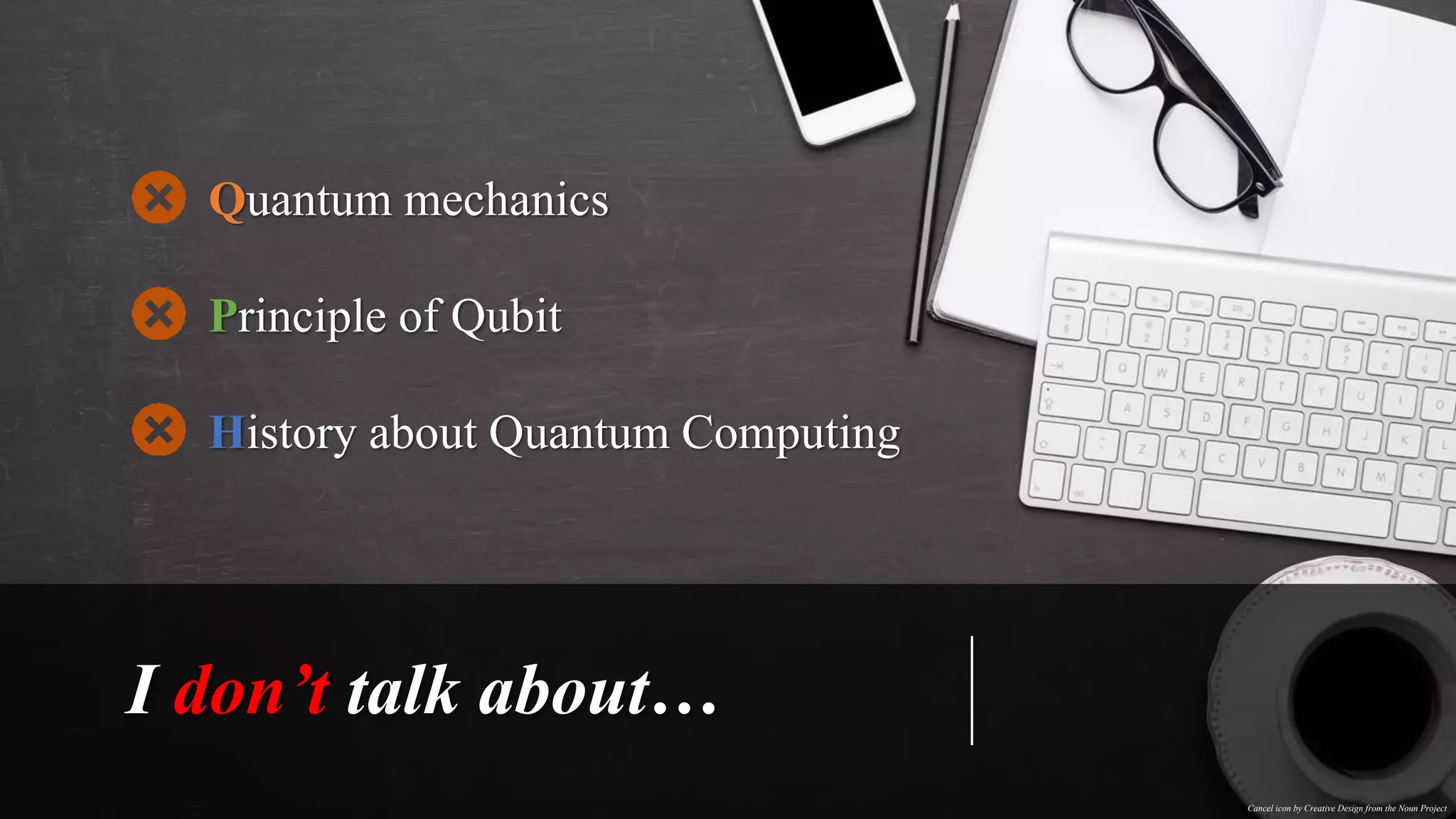

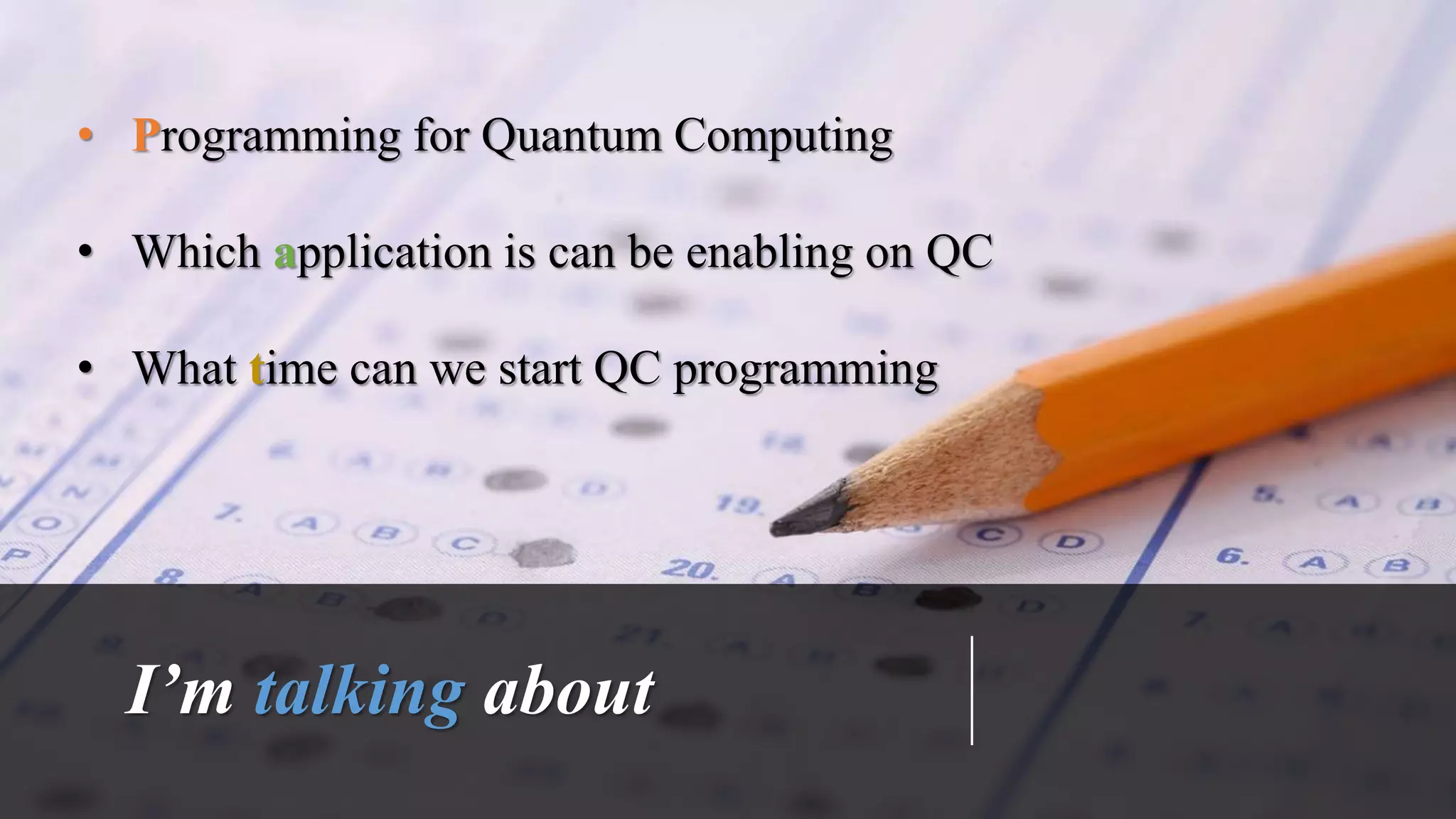
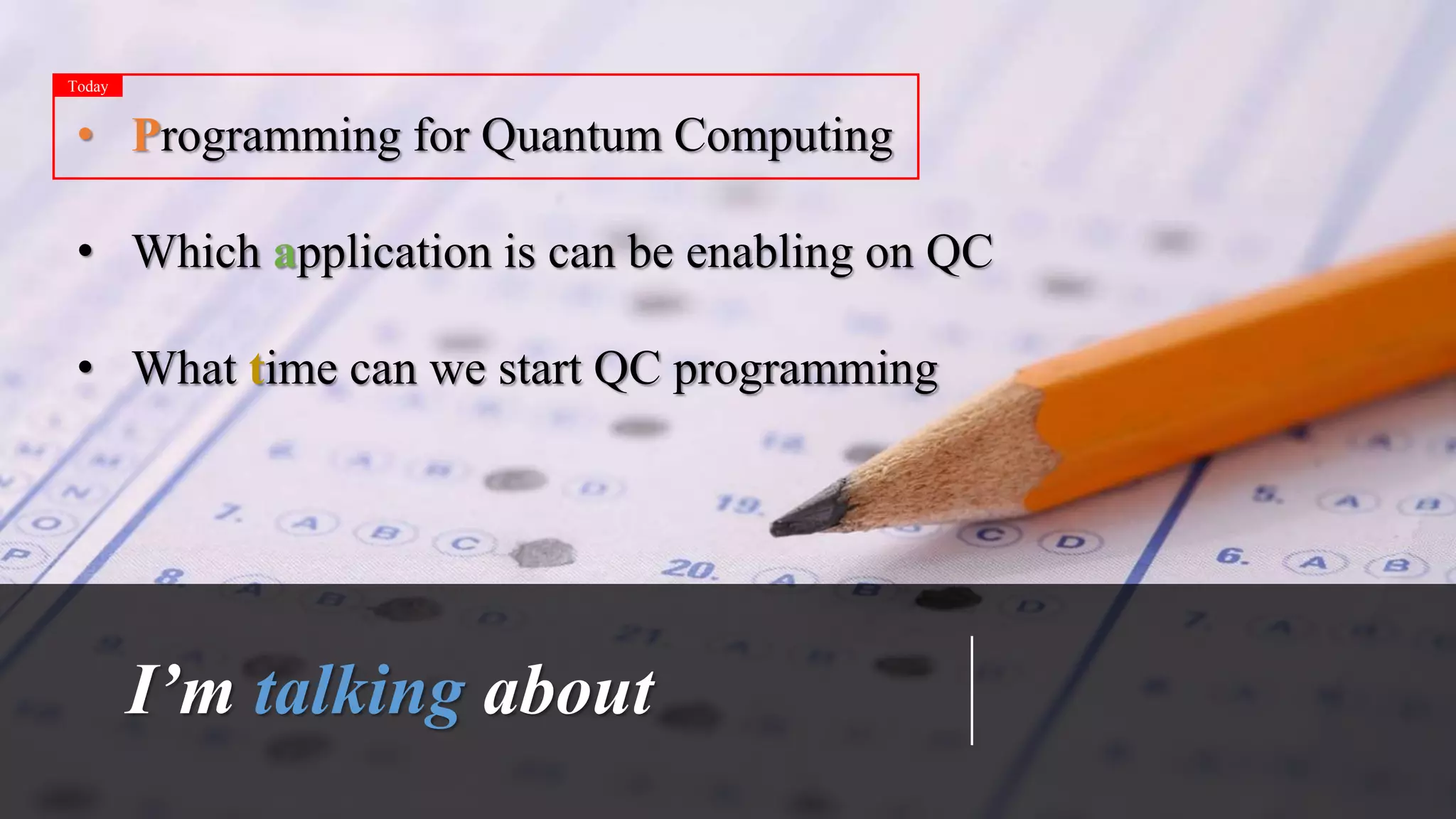
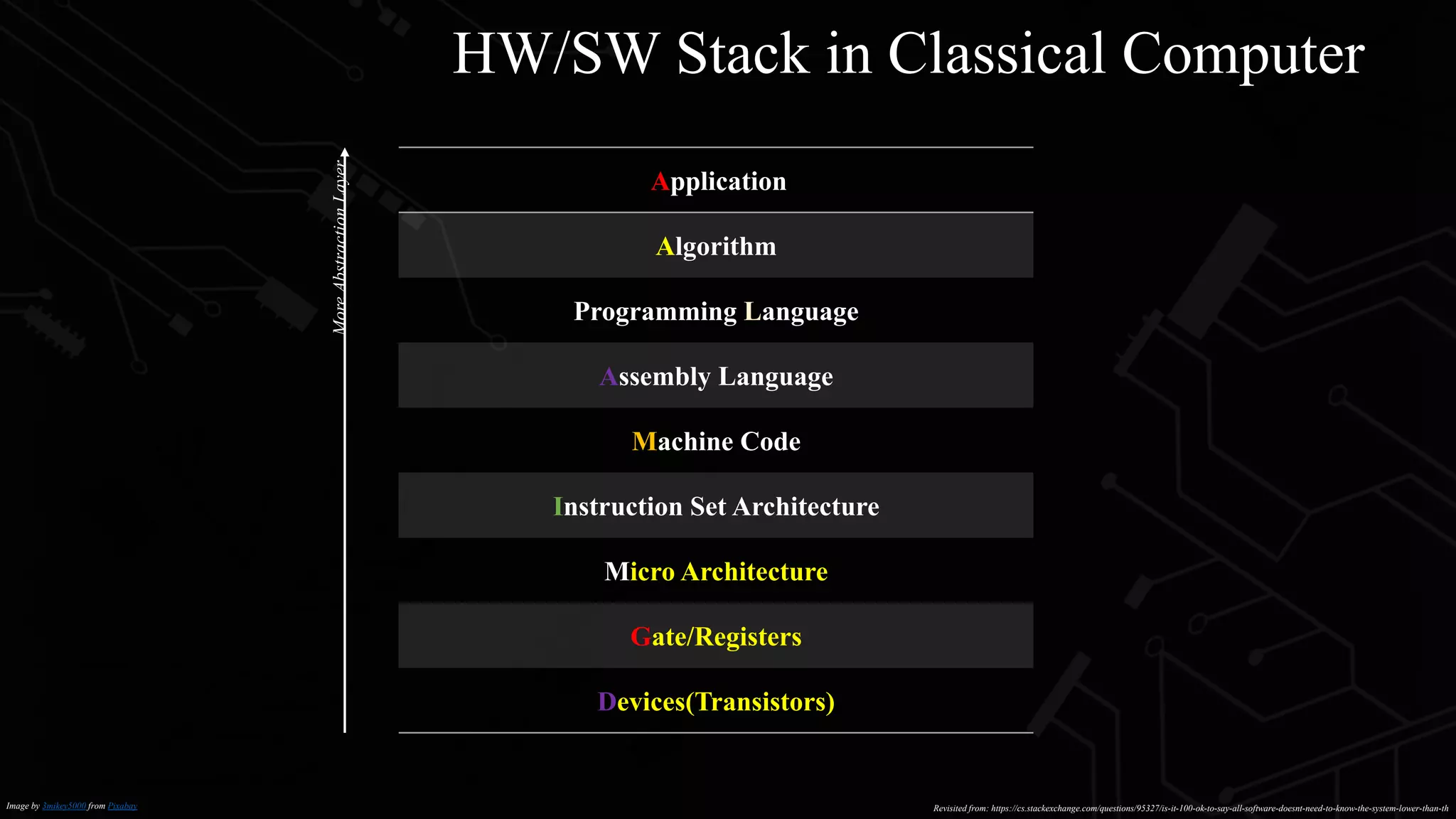
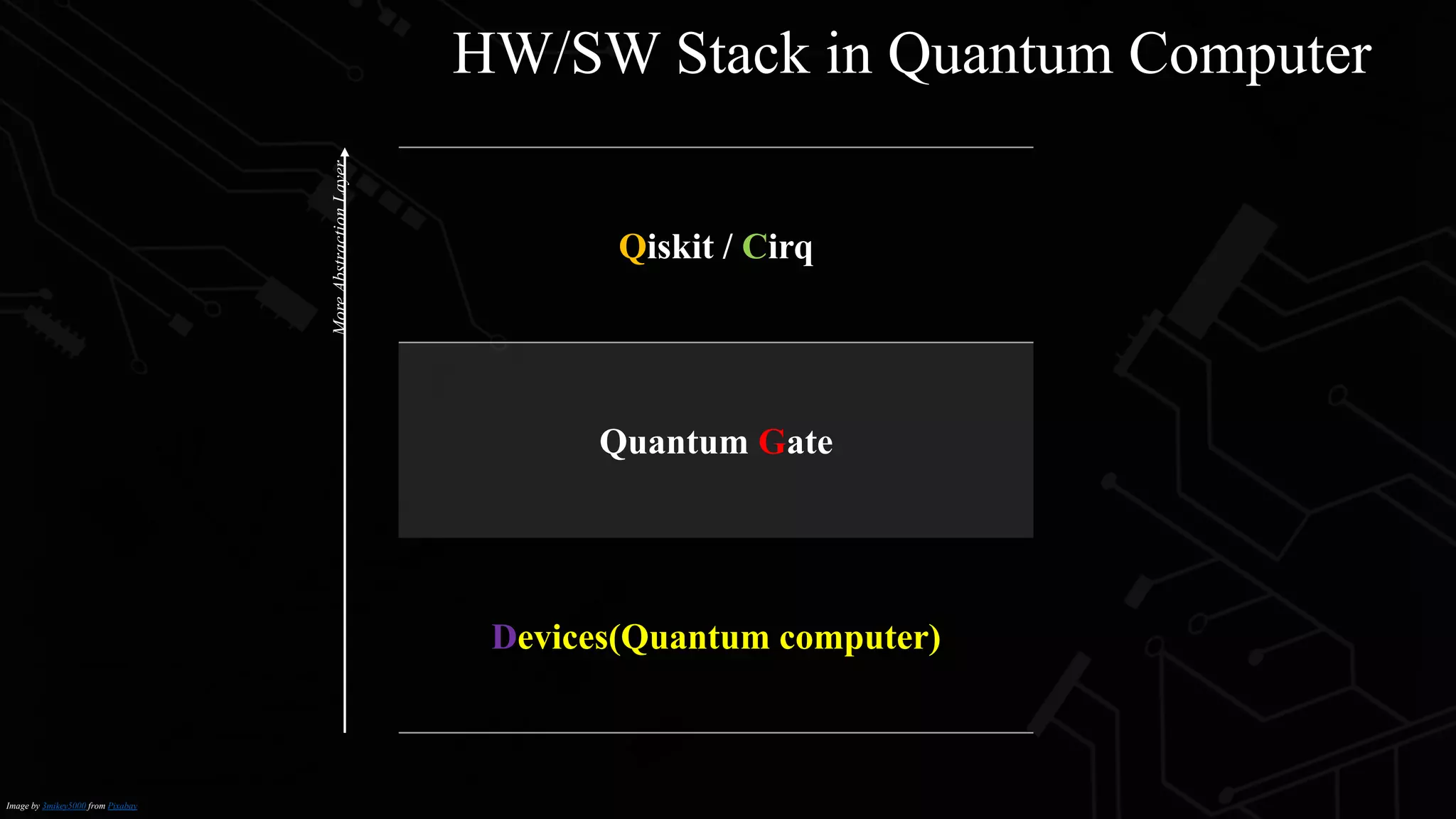
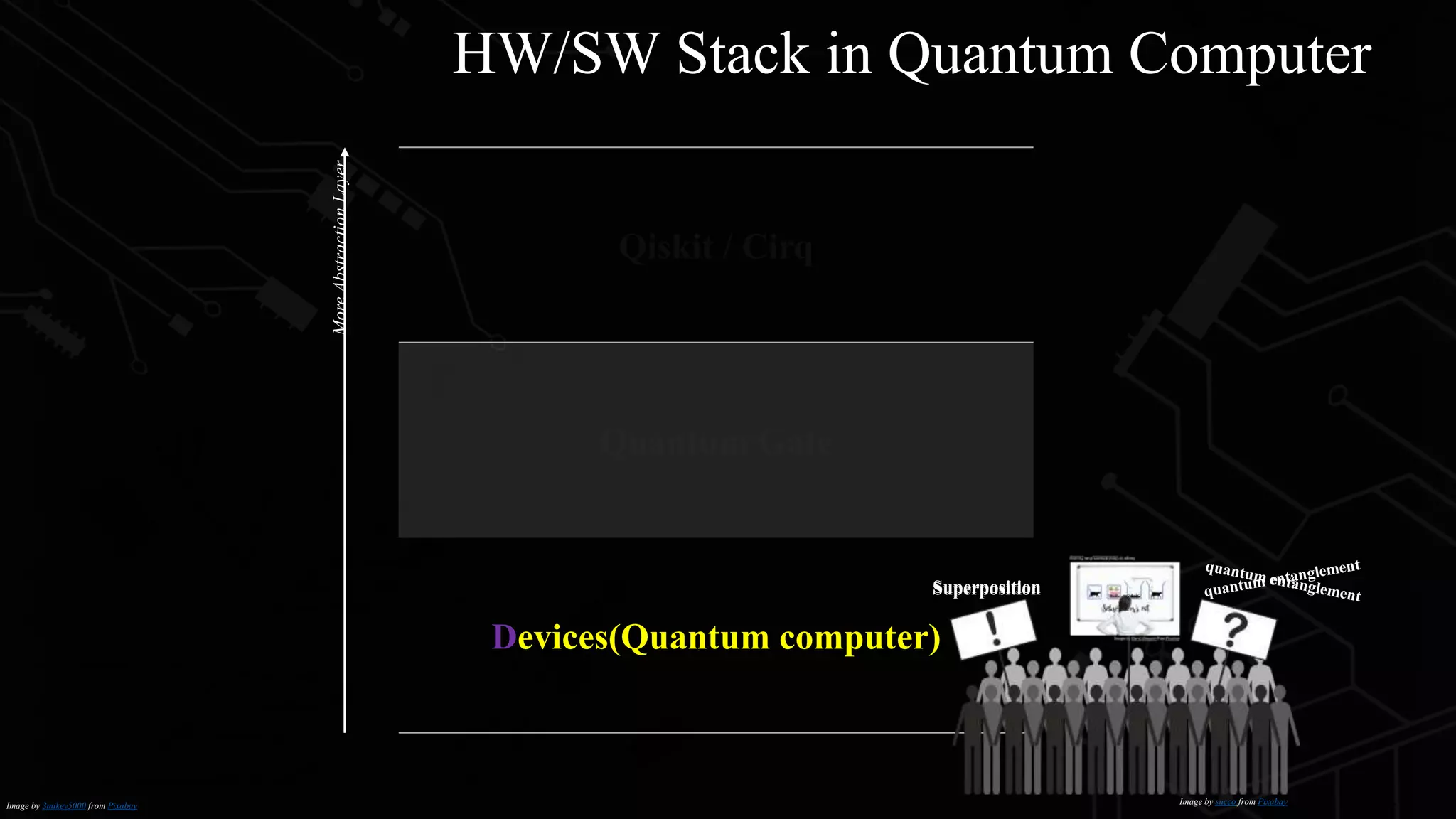
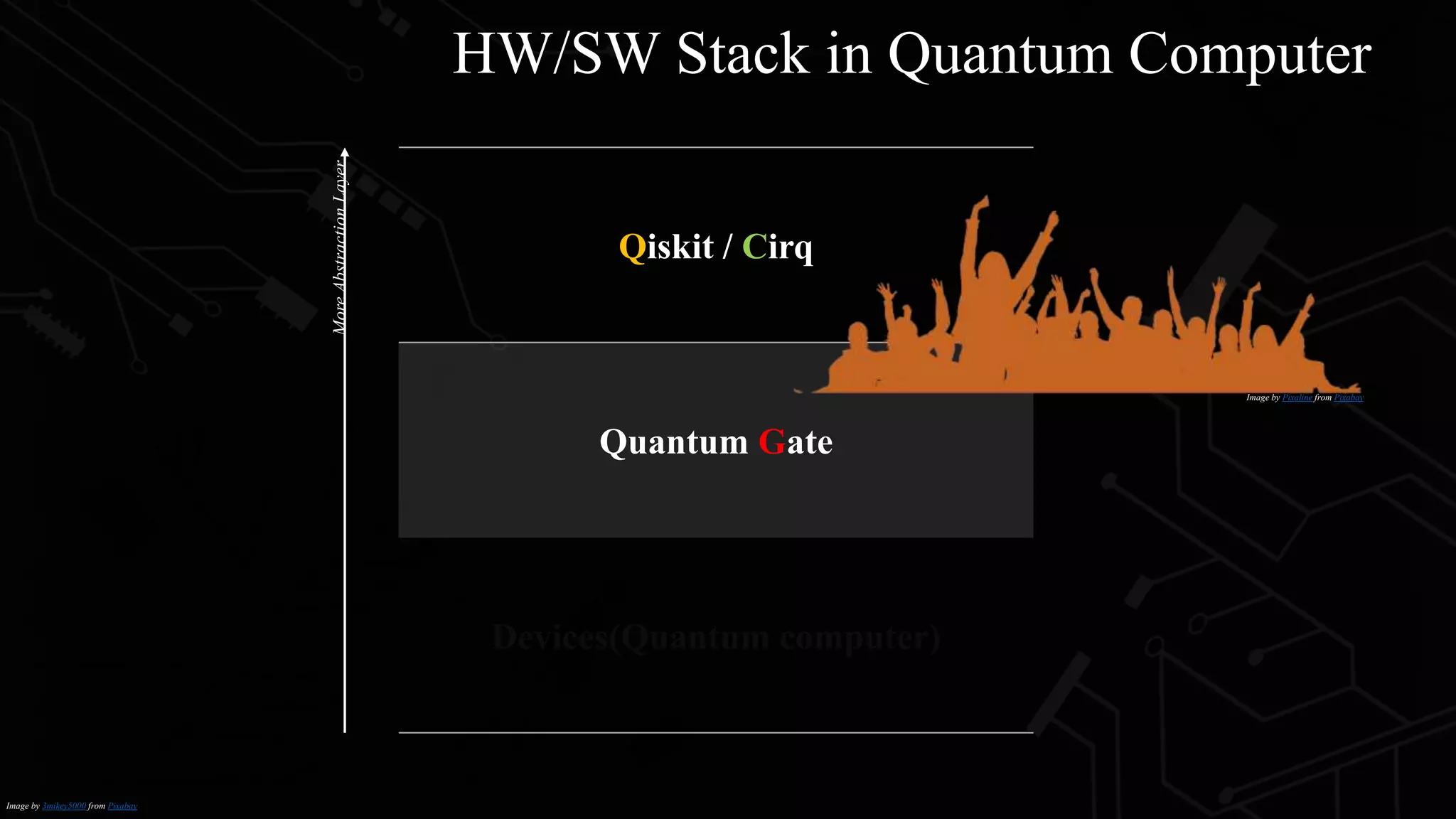
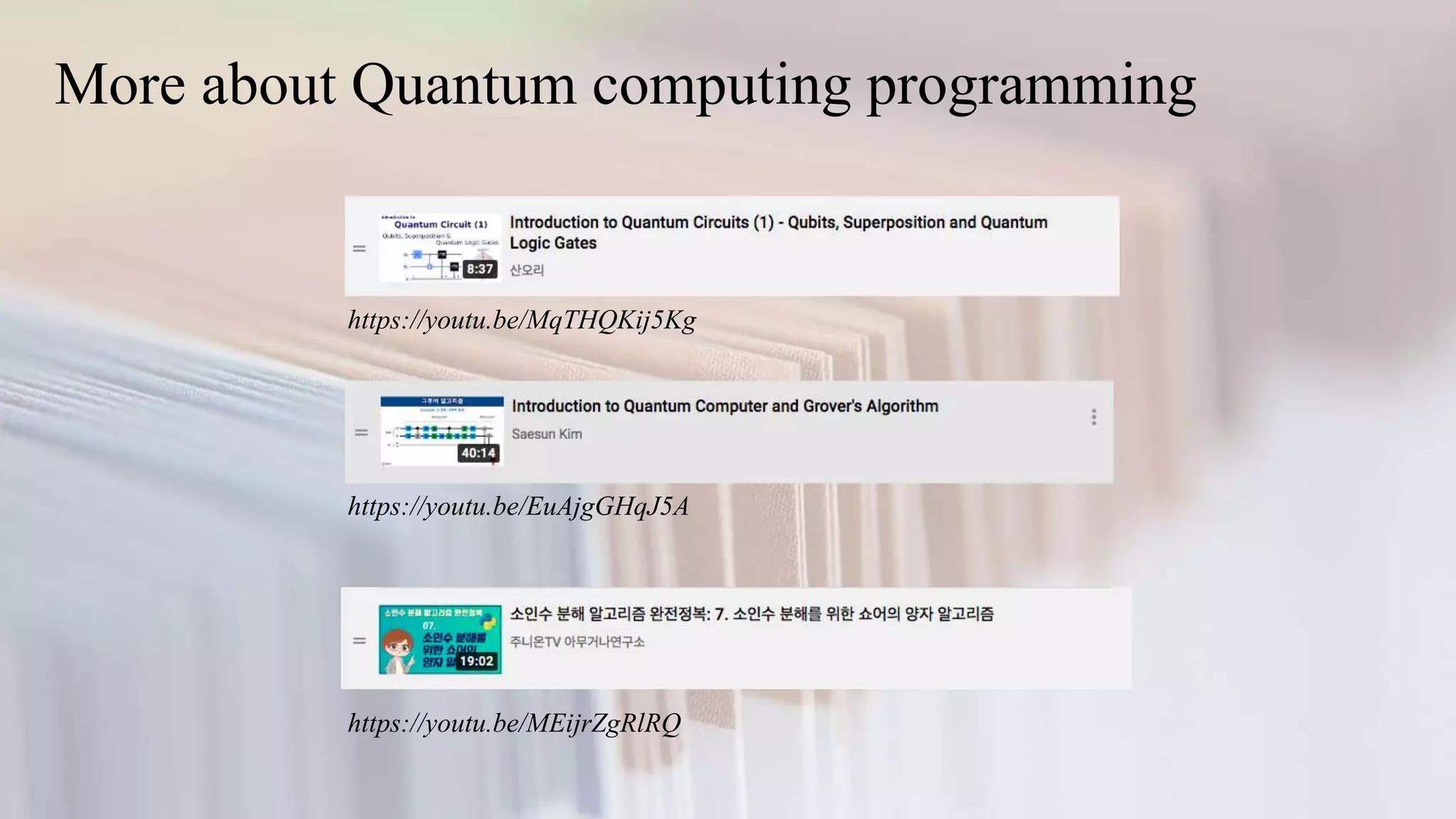
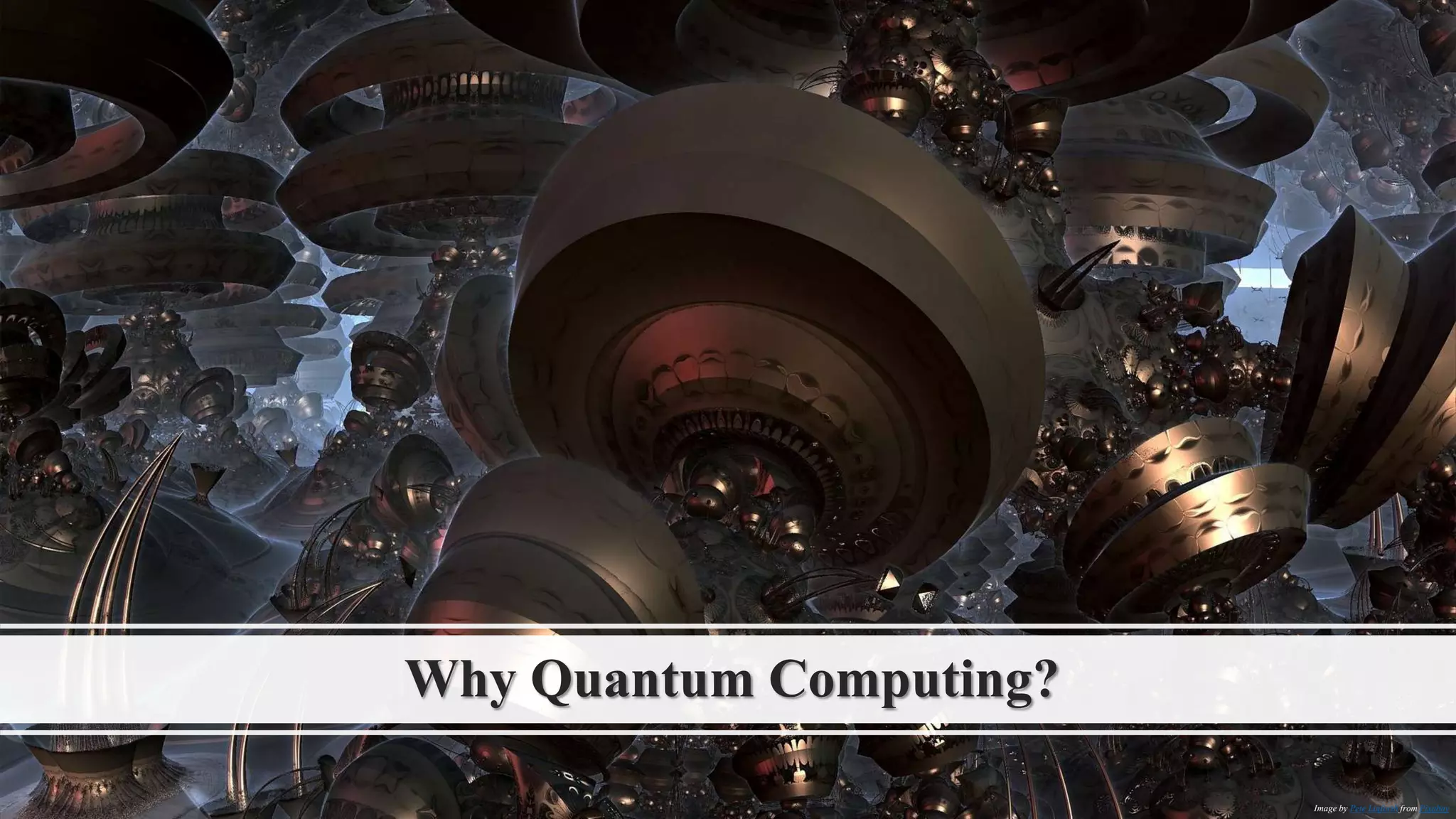
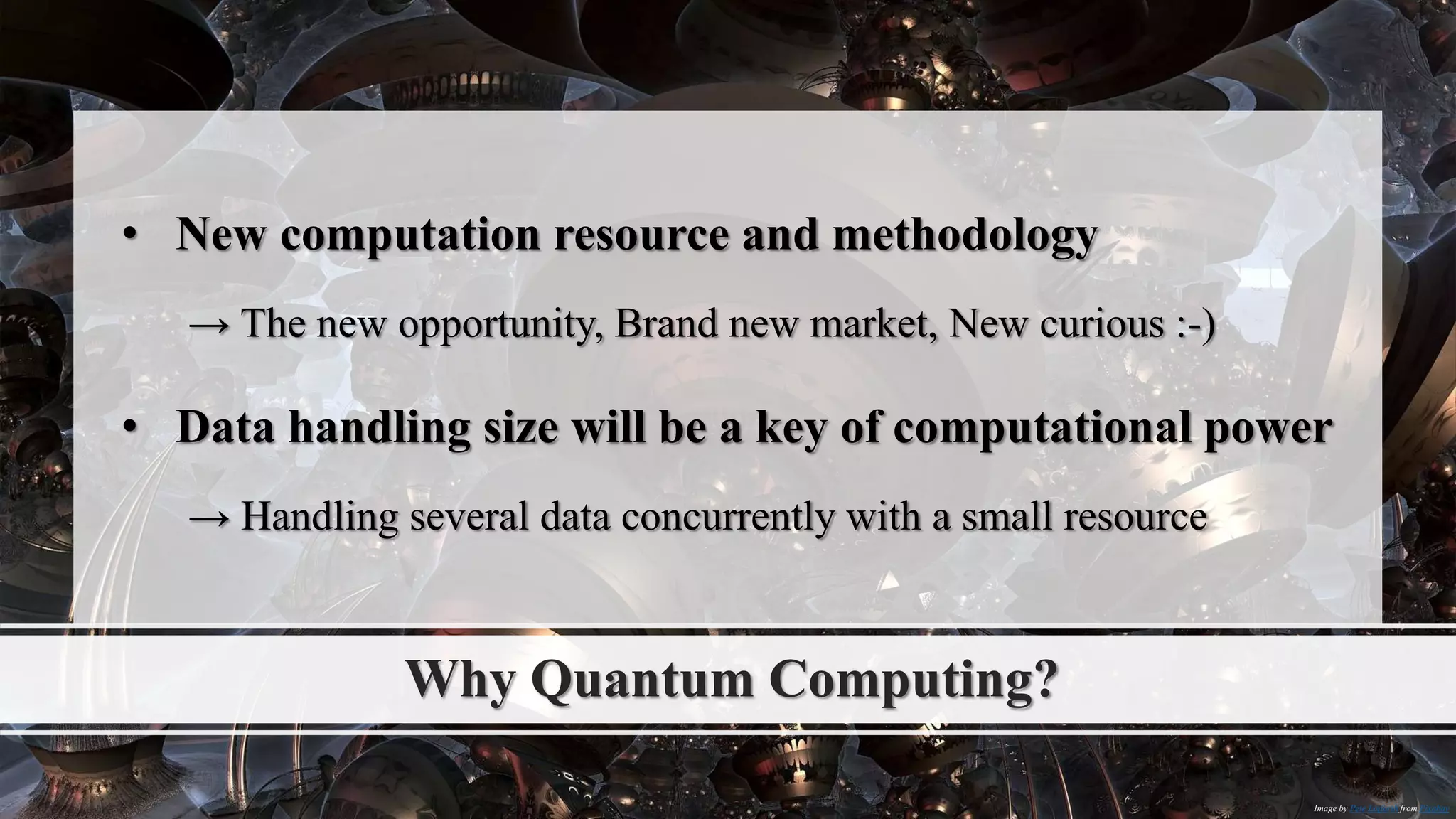
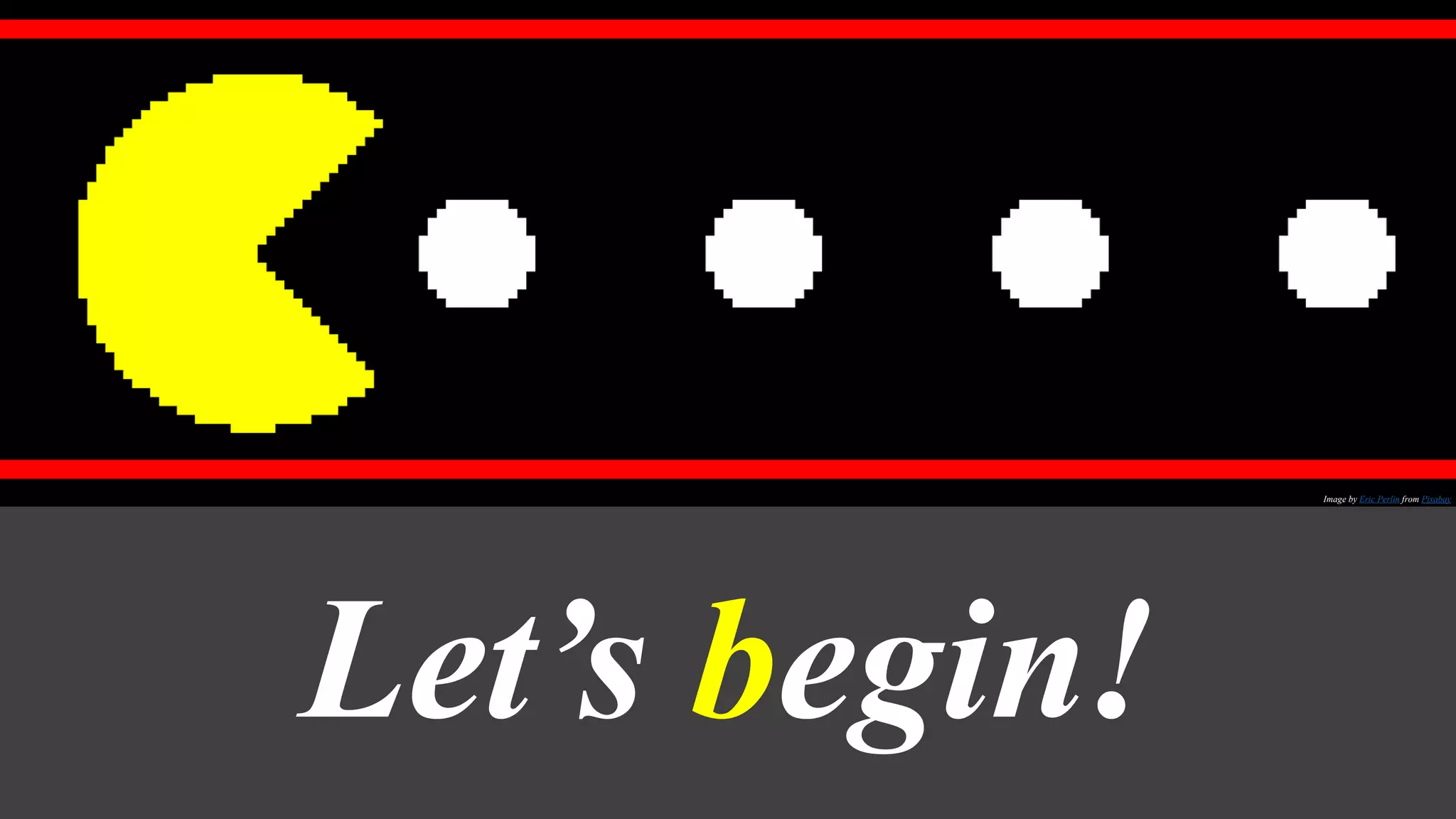
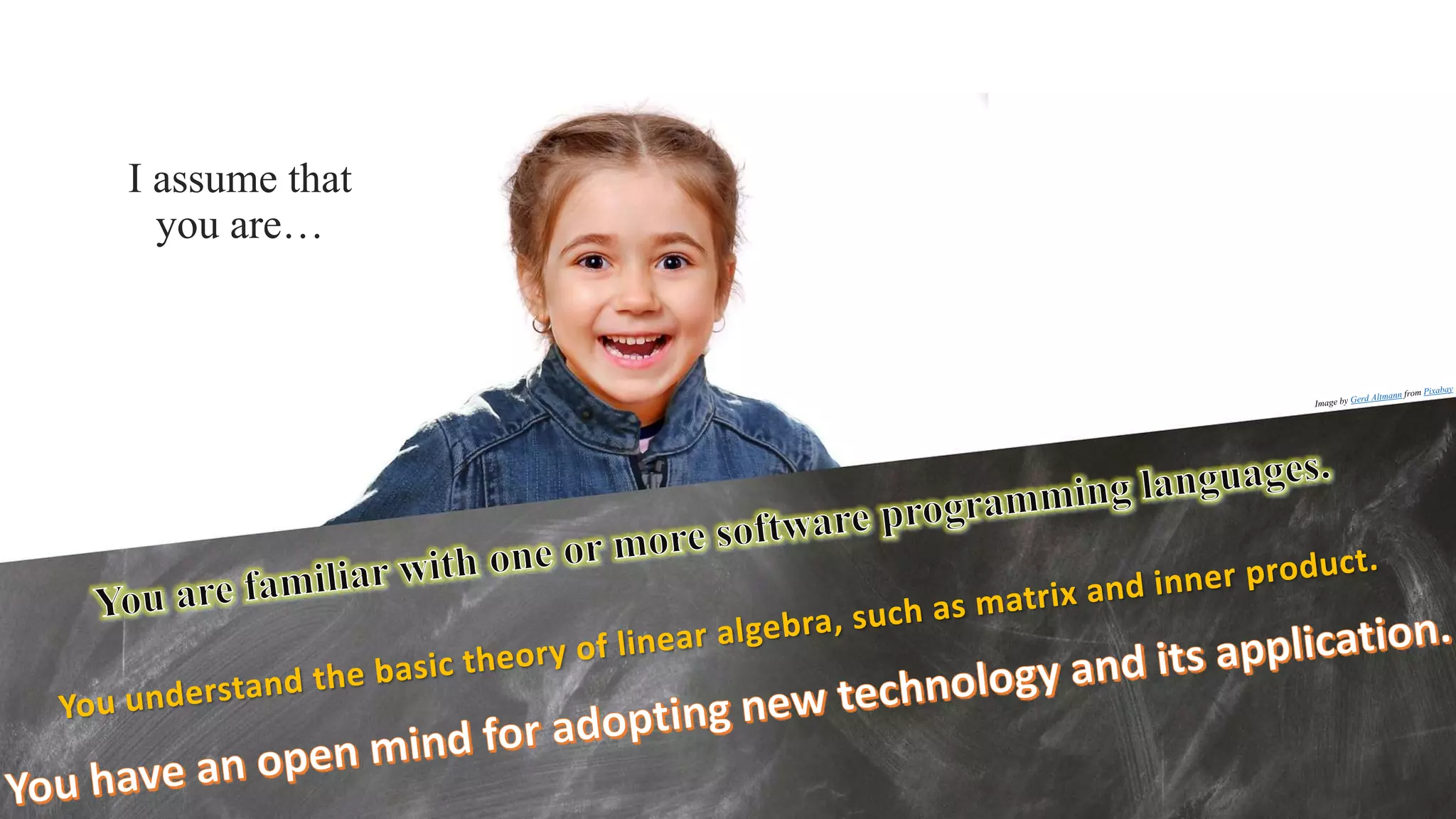
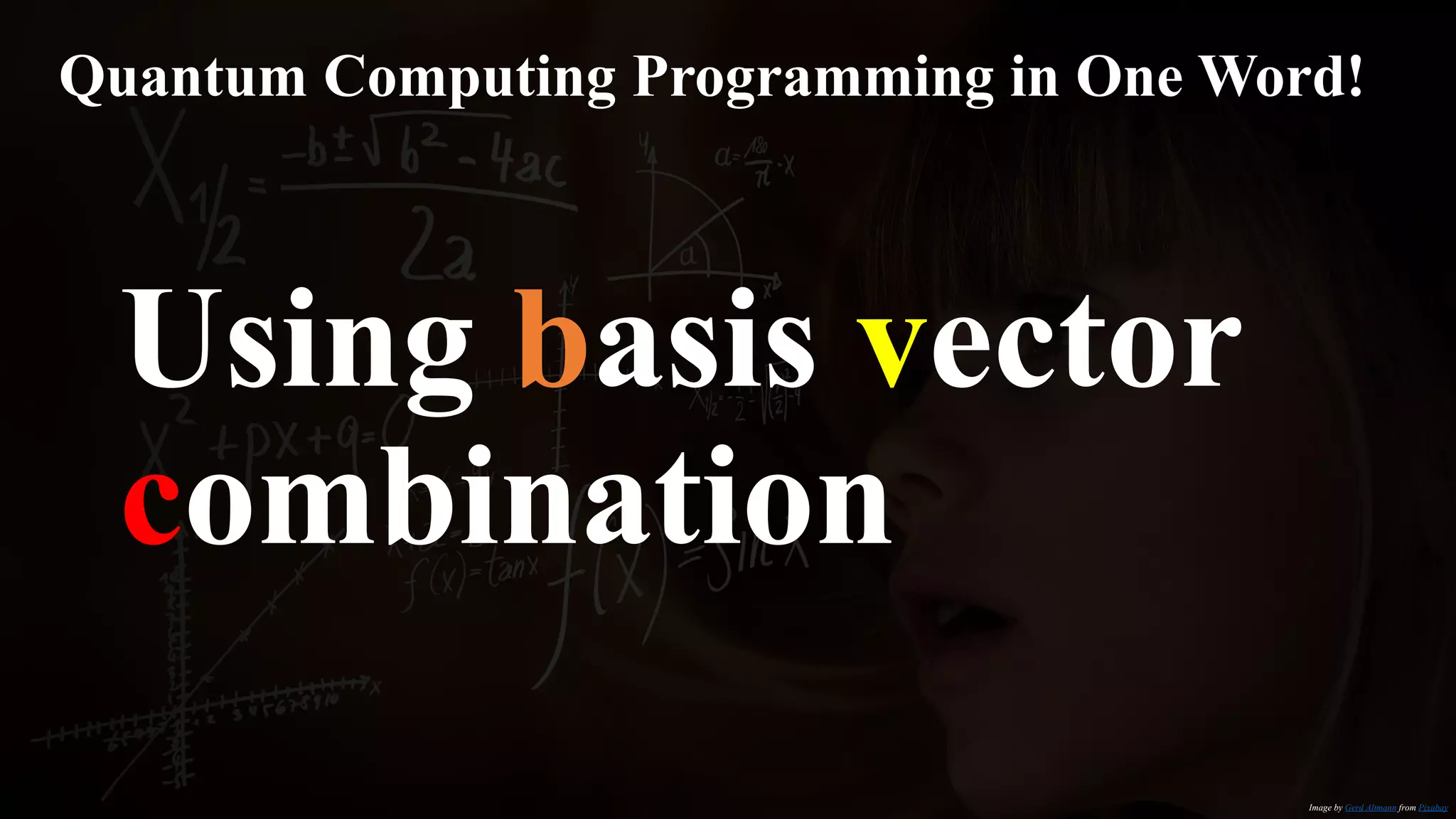

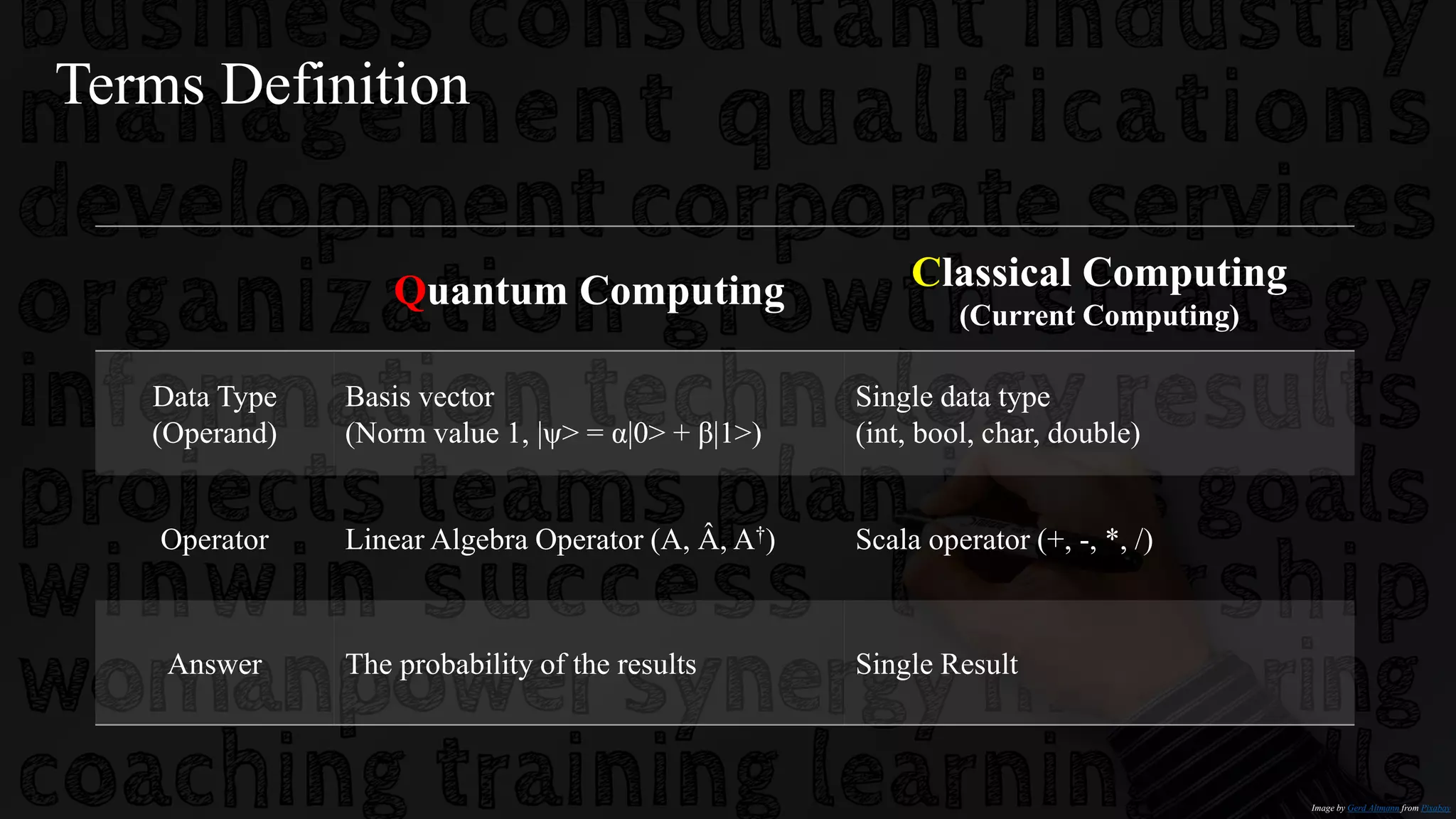
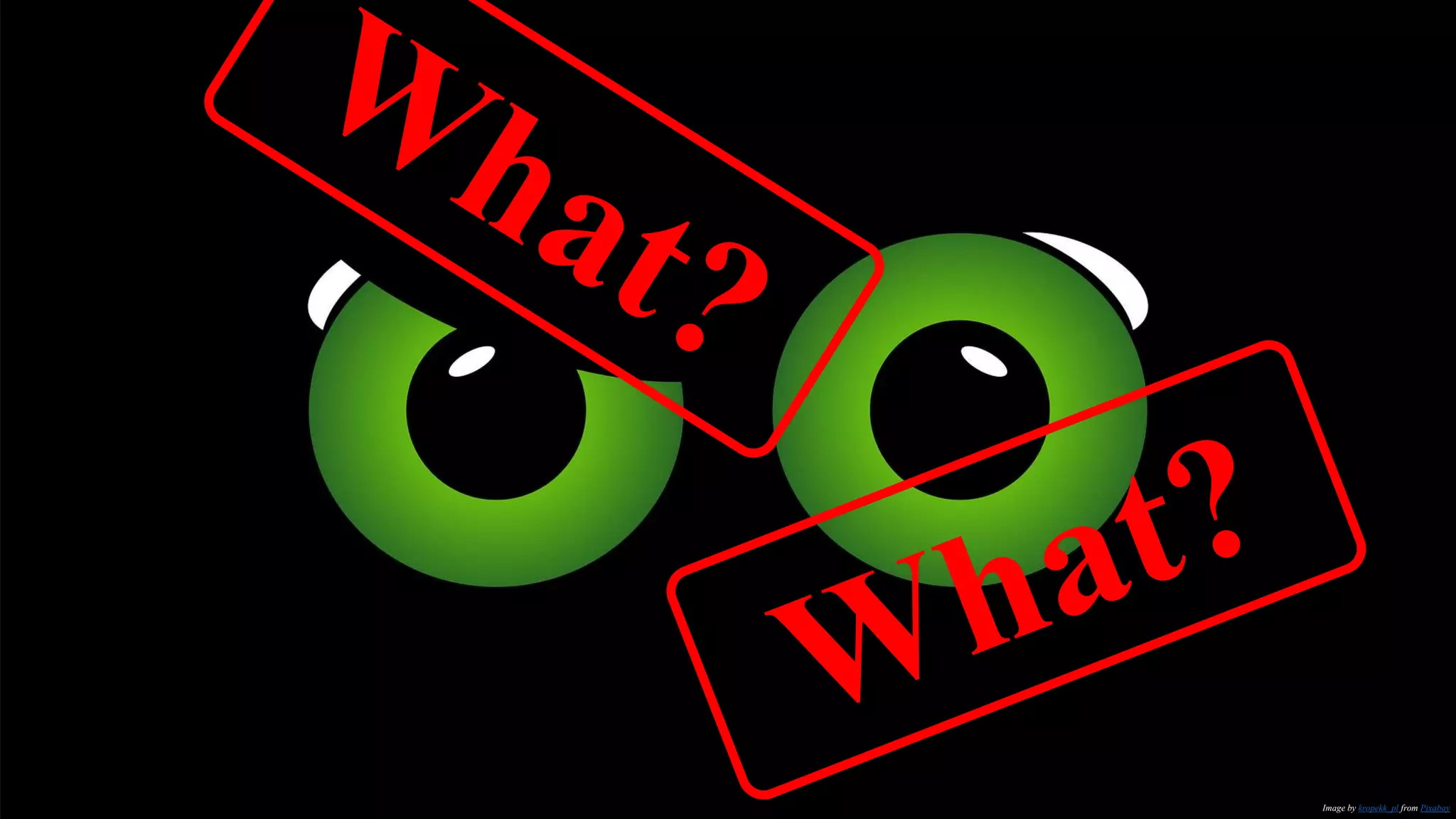
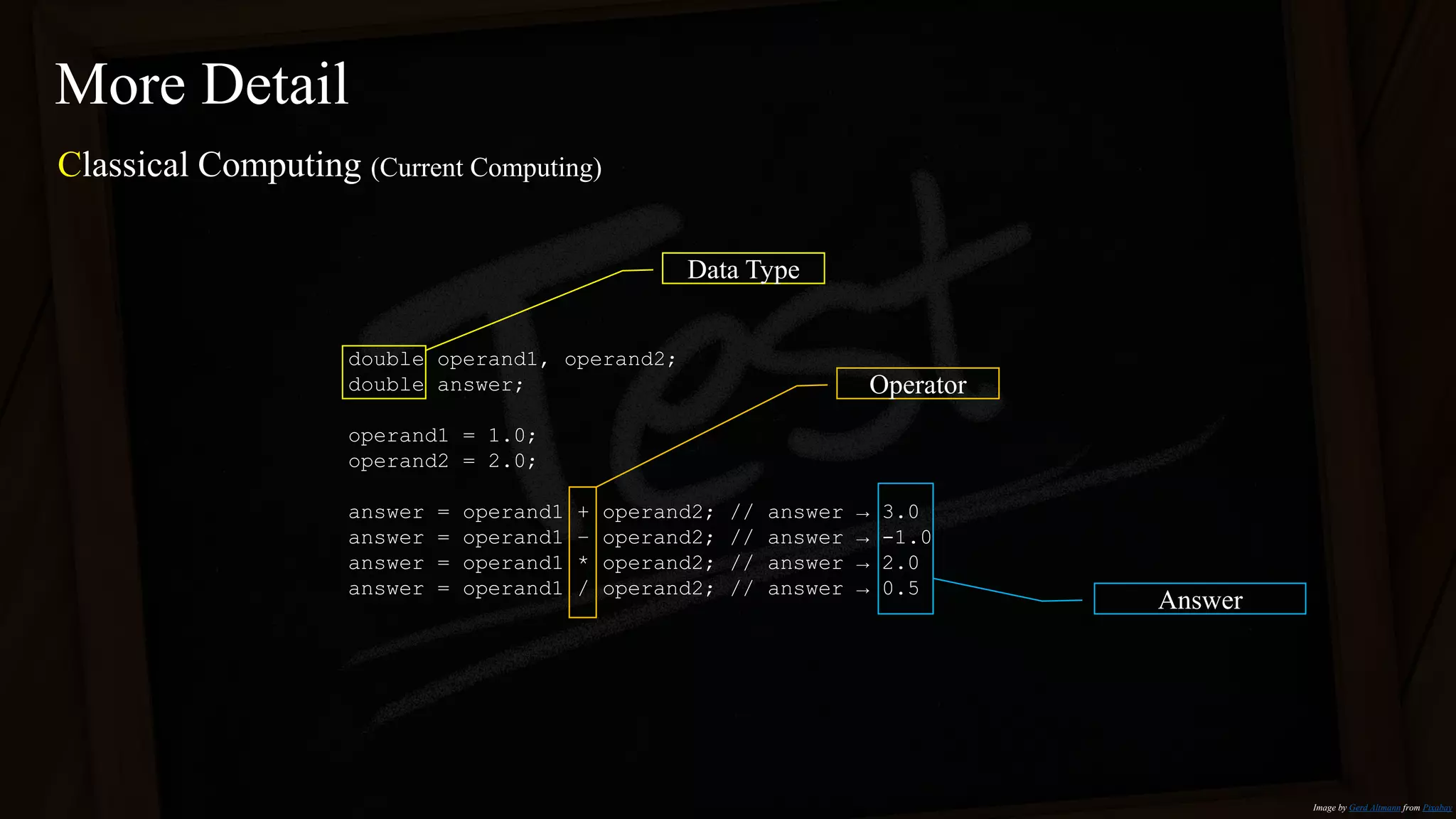
![More Detail Quantum Computing %matplotlib inline # Importing standard Qiskit libraries from qiskit import QuantumCircuit, execute, Aer, IBMQ from qiskit.visualization import * # Construct quantum circuit circ = QuantumCircuit(2,2) circ.h(0) circ.h(1) circ.cx(0, 1) circ.measure([0,1], [0,1]) # Select the QasmSimulator from the Aer provider simulator = Aer.get_backend('qasm_simulator') # Execute and get counts result = execute(circ, simulator).result() counts = result.get_counts(circ) Operator Answer Data Type 𝑞0 = 1 0 , 𝑞1 = 1 0 Image by Gerd Altmann from Pixabay](https://image.slidesharecdn.com/qcforappprogrammer-210212161029/75/Quantum-Computing-for-app-programmer-22-2048.jpg)
![More Detail Quantum Computing %matplotlib inline # Importing standard Qiskit libraries from qiskit import QuantumCircuit, execute, Aer, IBMQ from qiskit.visualization import * # Construct quantum circuit circ = QuantumCircuit(2,2) circ.h(0) circ.h(1) circ.cx(0, 1) circ.measure([0,1], [0,1]) # Select the QasmSimulator from the Aer provider simulator = Aer.get_backend('qasm_simulator') # Execute and get counts result = execute(circ, simulator).result() counts = result.get_counts(circ) Operator Answer Data Type 𝑞0 = 1 0 , 𝑞1 = 1 0 Image by Gerd Altmann from Pixabay Abstraction!](https://image.slidesharecdn.com/qcforappprogrammer-210212161029/75/Quantum-Computing-for-app-programmer-23-2048.jpg)
![More Detail Quantum Computing circ = QuantumCircuit(2,2) circ.h(0) circ.h(1) circ.cx(0, 1) circ.measure([0,1], [0,1]) 𝑞0 = |0 > = 1 0 , 𝑞1 = |0 > = 1 0 (𝐻 ⊗ 𝐻) |𝑞0 > ⊗ |𝑞1 > = 1 2 1 1 1 −1 1 1 1 −1 1 1 1 −1 −1 −1 −1 1 1 0 0 0 = 1 2 (|00> + |01> + |10> + |11>) = |𝑞01 > |𝑞0 > ⊗ |𝑞1 > = | 𝑞0 > < 𝑞1| = 1 1 0 0 1 0 = 1 0 0 0 CX |𝑞01> = 1 0 0 1 0 0 0 0 0 0 0 0 0 1 1 0 1 2 1 1 1 1 = 1 2 1 1 1 1 = |𝑞2> 𝑃𝑟(|00>) = < 00|𝑞2 > 2 = 1 4 , 𝑃𝑟(|01>) = < 01|𝑞2 > 2 = 1 4 , 𝑃𝑟(|10>) = < 10|𝑞2 > 2 = 1 4 , 𝑃𝑟(|11>) = < 11|𝑞2 > 2 = 1 4 Image by Gerd Altmann from Pixabay 𝐻 ⊗ 𝐻 = 1 2 1 1 1 −1 ⊗ 1 2 1 1 1 −1 = 1 2 1 1 1 −1 1 1 1 −1 1 1 1 −1 −1 −1 −1 1](https://image.slidesharecdn.com/qcforappprogrammer-210212161029/75/Quantum-Computing-for-app-programmer-24-2048.jpg)
![More Detail Quantum Computing circ = QuantumCircuit(2,2) circ.h(0) circ.h(1) circ.cx(0, 1) circ.measure([0,1], [0,1]) 𝑞0 = |0 > = 1 0 , 𝑞1 = |0 > = 1 0 (𝐻 ⊗ 𝐻) |𝑞0 > ⊗ |𝑞1 > = 1 2 1 1 1 −1 1 1 1 −1 1 1 1 −1 −1 −1 −1 1 1 0 0 0 = 1 2 (|00> + |01> + |10> + |11>) = |𝑞01 > |𝑞0 > ⊗ |𝑞1 > = | 𝑞0 > < 𝑞1| = 1 1 0 0 1 0 = 1 0 0 0 CX |𝑞01> = 1 0 0 1 0 0 0 0 0 0 0 0 0 1 1 0 1 2 1 1 1 1 = 1 2 1 1 1 1 = |𝑞2> Image by Gerd Altmann from Pixabay 𝐻 ⊗ 𝐻 = 1 2 1 1 1 −1 ⊗ 1 2 1 1 1 −1 = 1 2 1 1 1 −1 1 1 1 −1 1 1 1 −1 −1 −1 −1 1 Answer 𝑃𝑟(|00>) = < 00|𝑞2 > 2 = 1 4 , 𝑃𝑟(|01>) = < 01|𝑞2 > 2 = 1 4 , 𝑃𝑟(|10>) = < 10|𝑞2 > 2 = 1 4 , 𝑃𝑟(|11>) = < 11|𝑞2 > 2 = 1 4](https://image.slidesharecdn.com/qcforappprogrammer-210212161029/75/Quantum-Computing-for-app-programmer-25-2048.jpg)
![More Detail Quantum Computing circ = QuantumCircuit(2,2) circ.h(0) circ.h(1) circ.cx(0, 1) circ.measure([0,1], [0,1]) 𝑞0 = |0 > = 1 0 , 𝑞1 = |0 > = 1 0 (𝐻 ⊗ 𝐻) |𝑞0 > ⊗ |𝑞1 > = 1 2 1 1 1 −1 1 1 1 −1 1 1 1 −1 −1 −1 −1 1 1 0 0 0 = 1 2 (|00> + |01> + |10> + |11>) = |𝑞01 > |𝑞0 > ⊗ |𝑞1 > = | 𝑞0 > < 𝑞1| = 1 1 0 0 1 0 = 1 0 0 0 CX |𝑞01> = 1 0 0 1 0 0 0 0 0 0 0 0 0 1 1 0 1 2 1 1 1 1 = 1 2 1 1 1 1 = |𝑞2> Image by Gerd Altmann from Pixabay 𝐻 ⊗ 𝐻 = 1 2 1 1 1 −1 ⊗ 1 2 1 1 1 −1 = 1 2 1 1 1 −1 1 1 1 −1 1 1 1 −1 −1 −1 −1 1 Answer 𝑃𝑟(|00>) = < 00|𝑞2 > 2 = 1 4 , 𝑃𝑟(|01>) = < 01|𝑞2 > 2 = 1 4 , 𝑃𝑟(|10>) = < 10|𝑞2 > 2 = 1 4 , 𝑃𝑟(|11>) = < 11|𝑞2 > 2 = 1 4 • The Qubit shows probability of the results → Results will be changed a little bit on every trying (collapse)](https://image.slidesharecdn.com/qcforappprogrammer-210212161029/75/Quantum-Computing-for-app-programmer-26-2048.jpg)
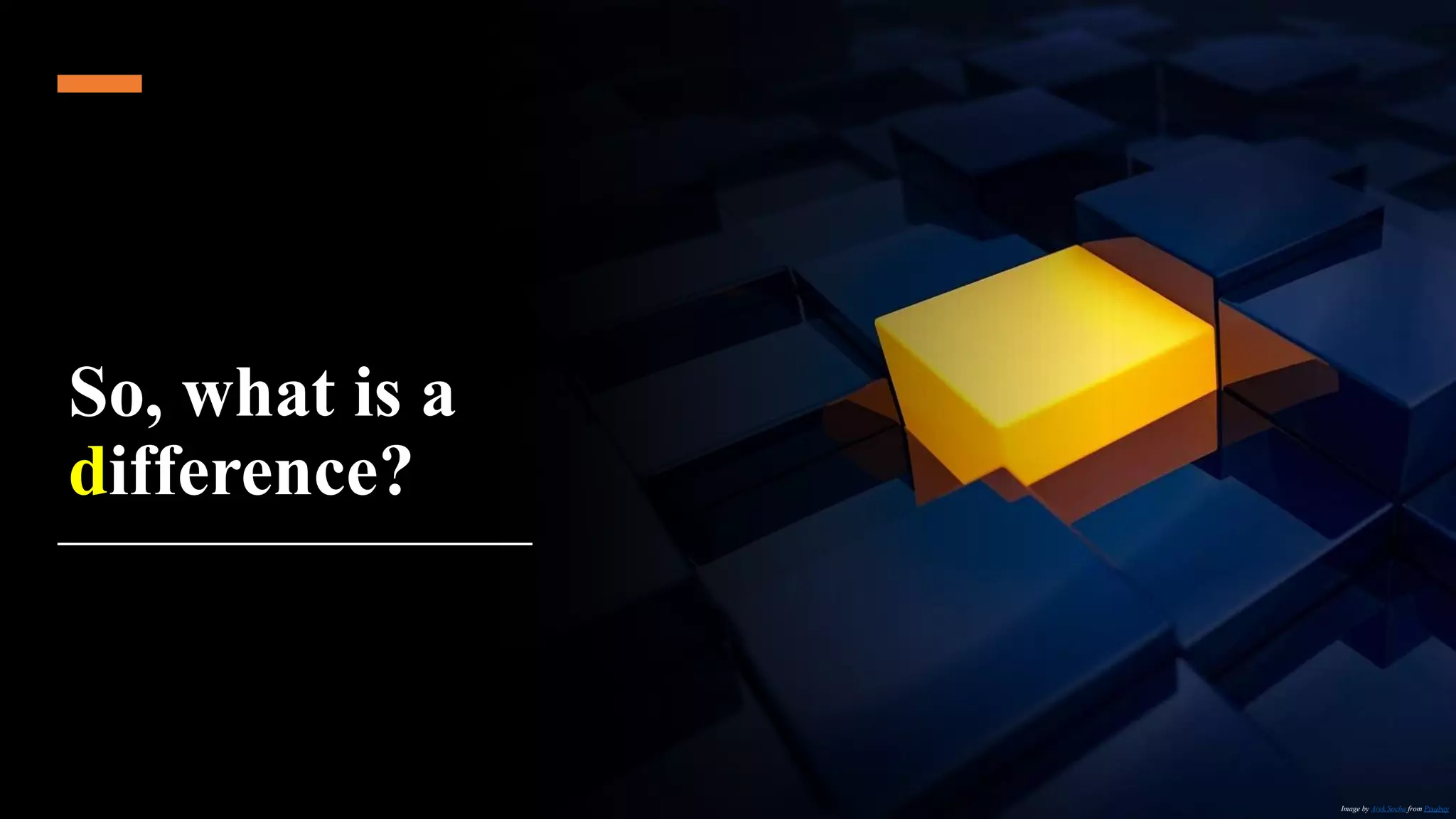
![Qubit vs. Vector in native programming Image by Gerd Altmann from Pixabay %matplotlib inline # Importing standard Qiskit libraries from qiskit import QuantumCircuit, execute, Aer, IBMQ from qiskit.visualization import * # Construct quantum circuit circ = QuantumCircuit(2,2) circ.h(0) circ.h(1) circ.cx(0, 1) circ.measure([0,1], [0,1]) # Select the QasmSimulator from the Aer provider simulator = Aer.get_backend('qasm_simulator') # Execute and get counts result = execute(circ, simulator).result() counts = result.get_counts(circ) Quantum Computing Classical Computing (Current Computing) Code on - https://github.com/mystous/quantumcomputing/blob/main/qubit_sim.cpp](https://image.slidesharecdn.com/qcforappprogrammer-210212161029/75/Quantum-Computing-for-app-programmer-28-2048.jpg)
![Qubit vs. Vector in native programming Image by Gerd Altmann from Pixabay %matplotlib inline # Importing standard Qiskit libraries from qiskit import QuantumCircuit, execute, Aer, IBMQ from qiskit.visualization import * # Construct quantum circuit circ = QuantumCircuit(2,2) circ.h(0) circ.h(1) circ.cx(0, 1) circ.measure([0,1], [0,1]) # Select the QasmSimulator from the Aer provider simulator = Aer.get_backend('qasm_simulator') # Execute and get counts result = execute(circ, simulator).result() counts = result.get_counts(circ) Quantum Computing Classical Computing (Current Computing) Code on - https://github.com/mystous/quantumcomputing/blob/main/qubit_sim.cpp](https://image.slidesharecdn.com/qcforappprogrammer-210212161029/75/Quantum-Computing-for-app-programmer-29-2048.jpg)
![Qubit vs. Vector in native programming Image by Gerd Altmann from Pixabay Quantum Computing Classical Computing (Current Computing) ‘Six states Bloch sphere.jpg’ from https://commons.wikimedia.org/wiki/File:Six_states_Bloch_sphere.jpg 2 Qubits q0 q1 256 bits q0[0] 00 q0[0] 01 q0[0] 02 q0[0] 03 q0[0] 04 q0[0] 05 q0[0] 06 q0[0] 07 q0[0] 08 q0[0] 09 q0[0] 10 q0[0] 11 q0[0] 12 q0[0] 13 q0[0] 14 q0[0] 15 q0[0] q0[0] 16 q0[0] 17 q0[0] 18 q0[0] 19 q0[0] 20 q0[0] 21 q0[0] 22 q0[0] 23 q0[0] 24 q0[0] 25 q0[0] 26 q0[0] 27 q0[0] 28 q0[0] 29 q0[0] 30 q0[0] 31 q0[0] 32 q0[0] 33 q0[0] 34 q0[0] 35 q0[0] 36 q0[0] 37 q0[0] 38 q0[0] 39 q0[0] 40 q0[0] 41 q0[0] 42 q0[0] 43 q0[0] 44 q0[0] 45 q0[0] 46 q0[0] 47 q0[0] 48 q0[0] 49 q0[0] 50 q0[0] 51 q0[0] 52 q0[0] 53 q0[0] 54 q0[0] 55 q0[0] 56 q0[0] 57 q0[0] 58 q0[0] 59 q0[0] 60 q0[0] 61 q0[0] 62 q0[0] 63 q0[1] 00 q0[1] 01 q0[1] 02 q0[1] 03 q0[1] 04 q0[1] 05 q0[1] 06 q0[1] 07 q0[1] 08 q0[1] 09 q0[1] 10 q0[1] 11 q0[1] 12 q0[1] 13 q0[1] 14 q0[1] 15 q0[1] q0[1] 16 q0[1] 17 q0[1] 18 q0[1] 19 q0[1] 20 q0[1] 21 q0[1] 22 q0[1] 23 q0[1] 24 q0[1] 25 q0[1] 26 q0[1] 27 q0[1] 28 q0[1] 29 q0[1] 30 q0[1] 31 q0[1] 32 q0[1] 33 q0[1] 34 q0[1] 35 q0[1] 36 q0[1] 37 q0[1] 38 q0[1] 39 q0[1] 40 q0[1] 41 q0[1] 42 q0[1] 43 q0[1] 44 q0[1] 45 q0[1] 46 q0[1] 47 q0[1] 48 q0[1] 49 q0[1] 50 q0[1] 51 q0[1] 52 q0[1] 53 q0[1] 54 q0[1] 55 q0[1] 56 q0[1] 57 q0[1] 58 q0[1] 59 q0[1] 60 q0[1] 61 q0[1] 62 q0[1] 63 q1[0] 00 q1[0] 01 q1[0] 02 q1[0] 03 q1[0] 04 q1[0] 05 q1[0] 06 q1[0] 07 q1[0] 08 q1[0] 09 q1[0] 10 q1[0] 11 q1[0] 12 q1[0] 13 q1[0] 14 q1[0] 15 q1[0] q1[0] 16 q1[0] 17 q1[0] 18 q1[0] 19 q1[0] 20 q1[0] 21 q1[0] 22 q1[0] 23 q1[0] 24 q1[0] 25 q1[0] 26 q1[0] 27 q1[0] 28 q1[0] 29 q1[0] 30 q1[0] 31 q1[0] 32 q1[0] 33 q1[0] 34 q1[0] 35 q1[0] 36 q1[0] 37 q1[0] 38 q1[0] 39 q1[0] 40 q1[0] 41 q1[0] 42 q1[0] 43 q1[0] 44 q1[0] 45 q1[0] 46 q1[0] 47 q1[0] 48 q1[0] 49 q1[0] 50 q1[0] 51 q1[0] 52 q1[0] 53 q1[0] 54 q1[0] 55 q1[0] 56 q1[0] 57 q1[0] 58 q1[0] 59 q1[0] 60 q1[0] 61 q1[0] 62 q1[0] 63 q1[1] 00 q1[1] 01 q1[1] 02 q1[1] 03 q1[1] 04 q1[1] 05 q1[1] 06 q1[1] 07 q1[1] 08 q1[1] 09 q1[1] 10 q1[1] 11 q1[1] 12 q1[1] 13 q1[1] 14 q1[1] 15 q1[1] q1[1] 16 q1[1] 17 q1[1] 18 q1[1] 19 q1[1] 20 q1[1] 21 q1[1] 22 q1[1] 23 q1[1] 24 q1[1] 25 q1[1] 26 q1[1] 27 q1[1] 28 q1[1] 29 q1[1] 30 q1[1] 31 q1[1] 32 q1[1] 33 q1[1] 34 q1[1] 35 q1[1] 36 q1[1] 37 q1[1] 38 q1[1] 39 q1[1] 40 q1[1] 41 q1[1] 42 q1[1] 43 q1[1] 44 q1[1] 45 q1[1] 46 q1[1] 47 q1[1] 48 q1[1] 49 q1[1] 50 q1[1] 51 q1[1] 52 q1[1] 53 q1[1] 54 q1[1] 55 q1[1] 56 q1[1] 57 q1[1] 58 q1[1] 59 q1[1] 60 q1[1] 61 q1[1] 62 q1[1] 63](https://image.slidesharecdn.com/qcforappprogrammer-210212161029/75/Quantum-Computing-for-app-programmer-30-2048.jpg)
![Qubit vs. Vector in native programming Image by Gerd Altmann from Pixabay Quantum Computing Classical Computing (Current Computing) ‘Six states Bloch sphere.jpg’ from https://commons.wikimedia.org/wiki/File:Six_states_Bloch_sphere.jpg 2 Qubits q0 q1 256 bits q0[0] 00 q0[0] 01 q0[0] 02 q0[0] 03 q0[0] 04 q0[0] 05 q0[0] 06 q0[0] 07 q0[0] 08 q0[0] 09 q0[0] 10 q0[0] 11 q0[0] 12 q0[0] 13 q0[0] 14 q0[0] 15 q0[0] q0[0] 16 q0[0] 17 q0[0] 18 q0[0] 19 q0[0] 20 q0[0] 21 q0[0] 22 q0[0] 23 q0[0] 24 q0[0] 25 q0[0] 26 q0[0] 27 q0[0] 28 q0[0] 29 q0[0] 30 q0[0] 31 q0[0] 32 q0[0] 33 q0[0] 34 q0[0] 35 q0[0] 36 q0[0] 37 q0[0] 38 q0[0] 39 q0[0] 40 q0[0] 41 q0[0] 42 q0[0] 43 q0[0] 44 q0[0] 45 q0[0] 46 q0[0] 47 q0[0] 48 q0[0] 49 q0[0] 50 q0[0] 51 q0[0] 52 q0[0] 53 q0[0] 54 q0[0] 55 q0[0] 56 q0[0] 57 q0[0] 58 q0[0] 59 q0[0] 60 q0[0] 61 q0[0] 62 q0[0] 63 q0[1] 00 q0[1] 01 q0[1] 02 q0[1] 03 q0[1] 04 q0[1] 05 q0[1] 06 q0[1] 07 q0[1] 08 q0[1] 09 q0[1] 10 q0[1] 11 q0[1] 12 q0[1] 13 q0[1] 14 q0[1] 15 q0[1] q0[1] 16 q0[1] 17 q0[1] 18 q0[1] 19 q0[1] 20 q0[1] 21 q0[1] 22 q0[1] 23 q0[1] 24 q0[1] 25 q0[1] 26 q0[1] 27 q0[1] 28 q0[1] 29 q0[1] 30 q0[1] 31 q0[1] 32 q0[1] 33 q0[1] 34 q0[1] 35 q0[1] 36 q0[1] 37 q0[1] 38 q0[1] 39 q0[1] 40 q0[1] 41 q0[1] 42 q0[1] 43 q0[1] 44 q0[1] 45 q0[1] 46 q0[1] 47 q0[1] 48 q0[1] 49 q0[1] 50 q0[1] 51 q0[1] 52 q0[1] 53 q0[1] 54 q0[1] 55 q0[1] 56 q0[1] 57 q0[1] 58 q0[1] 59 q0[1] 60 q0[1] 61 q0[1] 62 q0[1] 63 q1[0] 00 q1[0] 01 q1[0] 02 q1[0] 03 q1[0] 04 q1[0] 05 q1[0] 06 q1[0] 07 q1[0] 08 q1[0] 09 q1[0] 10 q1[0] 11 q1[0] 12 q1[0] 13 q1[0] 14 q1[0] 15 q1[0] q1[0] 16 q1[0] 17 q1[0] 18 q1[0] 19 q1[0] 20 q1[0] 21 q1[0] 22 q1[0] 23 q1[0] 24 q1[0] 25 q1[0] 26 q1[0] 27 q1[0] 28 q1[0] 29 q1[0] 30 q1[0] 31 q1[0] 32 q1[0] 33 q1[0] 34 q1[0] 35 q1[0] 36 q1[0] 37 q1[0] 38 q1[0] 39 q1[0] 40 q1[0] 41 q1[0] 42 q1[0] 43 q1[0] 44 q1[0] 45 q1[0] 46 q1[0] 47 q1[0] 48 q1[0] 49 q1[0] 50 q1[0] 51 q1[0] 52 q1[0] 53 q1[0] 54 q1[0] 55 q1[0] 56 q1[0] 57 q1[0] 58 q1[0] 59 q1[0] 60 q1[0] 61 q1[0] 62 q1[0] 63 q1[1] 00 q1[1] 01 q1[1] 02 q1[1] 03 q1[1] 04 q1[1] 05 q1[1] 06 q1[1] 07 q1[1] 08 q1[1] 09 q1[1] 10 q1[1] 11 q1[1] 12 q1[1] 13 q1[1] 14 q1[1] 15 q1[1] q1[1] 16 q1[1] 17 q1[1] 18 q1[1] 19 q1[1] 20 q1[1] 21 q1[1] 22 q1[1] 23 q1[1] 24 q1[1] 25 q1[1] 26 q1[1] 27 q1[1] 28 q1[1] 29 q1[1] 30 q1[1] 31 q1[1] 32 q1[1] 33 q1[1] 34 q1[1] 35 q1[1] 36 q1[1] 37 q1[1] 38 q1[1] 39 q1[1] 40 q1[1] 41 q1[1] 42 q1[1] 43 q1[1] 44 q1[1] 45 q1[1] 46 q1[1] 47 q1[1] 48 q1[1] 49 q1[1] 50 q1[1] 51 q1[1] 52 q1[1] 53 q1[1] 54 q1[1] 55 q1[1] 56 q1[1] 57 q1[1] 58 q1[1] 59 q1[1] 60 q1[1] 61 q1[1] 62 q1[1] 63 Why?](https://image.slidesharecdn.com/qcforappprogrammer-210212161029/75/Quantum-Computing-for-app-programmer-31-2048.jpg)
![Qubit vs. Vector in native programming Image by Gerd Altmann from Pixabay Quantum Computing Classical Computing (Current Computing) ‘Six states Bloch sphere.jpg’ from https://commons.wikimedia.org/wiki/File:Six_states_Bloch_sphere.jpg qubit |ψ> = α|0> + β|1> bits (vector) q[0] 00 q[0] 01 q[0] 02 q[0] 03 q[0] 04 q[0] 05 q[0] 06 q[0] 07 q[0] 08 q[0] 09 q[0] 10 q[0] 11 q[0] 12 q[0] 13 q[0] 14 q[0] 15 q[0] 16 q[0] 17 q[0] 18 q[0] 19 q[0] 20 q[0] 21 q[0] 22 q[0] 23 q[0] 24 q[0] 25 q[0] 26 q[0] 27 q[0] 28 q[0] 29 q[0] 30 q[0] 31 q[0] 32 q[0] 33 q[0] 34 q[0] 35 q[0] 36 q[0] 37 q[0] 38 q[0] 39 q[0] 40 q[0] 41 q[0] 42 q[0] 43 q[0] 44 q[0] 45 q[0] 46 q[0] 47 q[0] 48 q[0] 49 q[0] 50 q[0] 51 q[0] 52 q[0] 53 q[0] 54 q[0] 55 q[0] 56 q[0] 57 q[0] 58 q[0] 59 q[0] 60 q[0] 61 q[0] 62 q[0] 63 q[1] 00 q[1] 01 q[1] 02 q[1] 03 q[1] 04 q[1] 05 q[1] 06 q[1] 07 q[1] 08 q[1] 09 q[1] 10 q[1] 11 q[1] 12 q[1] 13 q[1] 14 q[1] 15 q[1] 16 q[1] 17 q[1] 18 q[1] 19 q[1] 20 q[1] 21 q[1] 22 q[1] 23 q[1] 24 q[1] 25 q[1] 26 q[1] 27 q[1] 28 q[1] 29 q[1] 30 q[1] 31 q[1] 32 q[1] 33 q[1] 34 q[1] 35 q[1] 36 q[1] 37 q[1] 38 q[1] 39 q[1] 40 q[1] 41 q[1] 42 q[1] 43 q[1] 44 q[1] 45 q[1] 46 q[1] 47 q[1] 48 q[1] 49 q[1] 50 q[1] 51 q[1] 52 q[1] 53 q[1] 54 q[1] 55 q[1] 56 q[1] 57 q[1] 58 q[1] 59 q[1] 60 q[1] 61 q[1] 62 q[1] 63 double q[2];](https://image.slidesharecdn.com/qcforappprogrammer-210212161029/75/Quantum-Computing-for-app-programmer-32-2048.jpg)
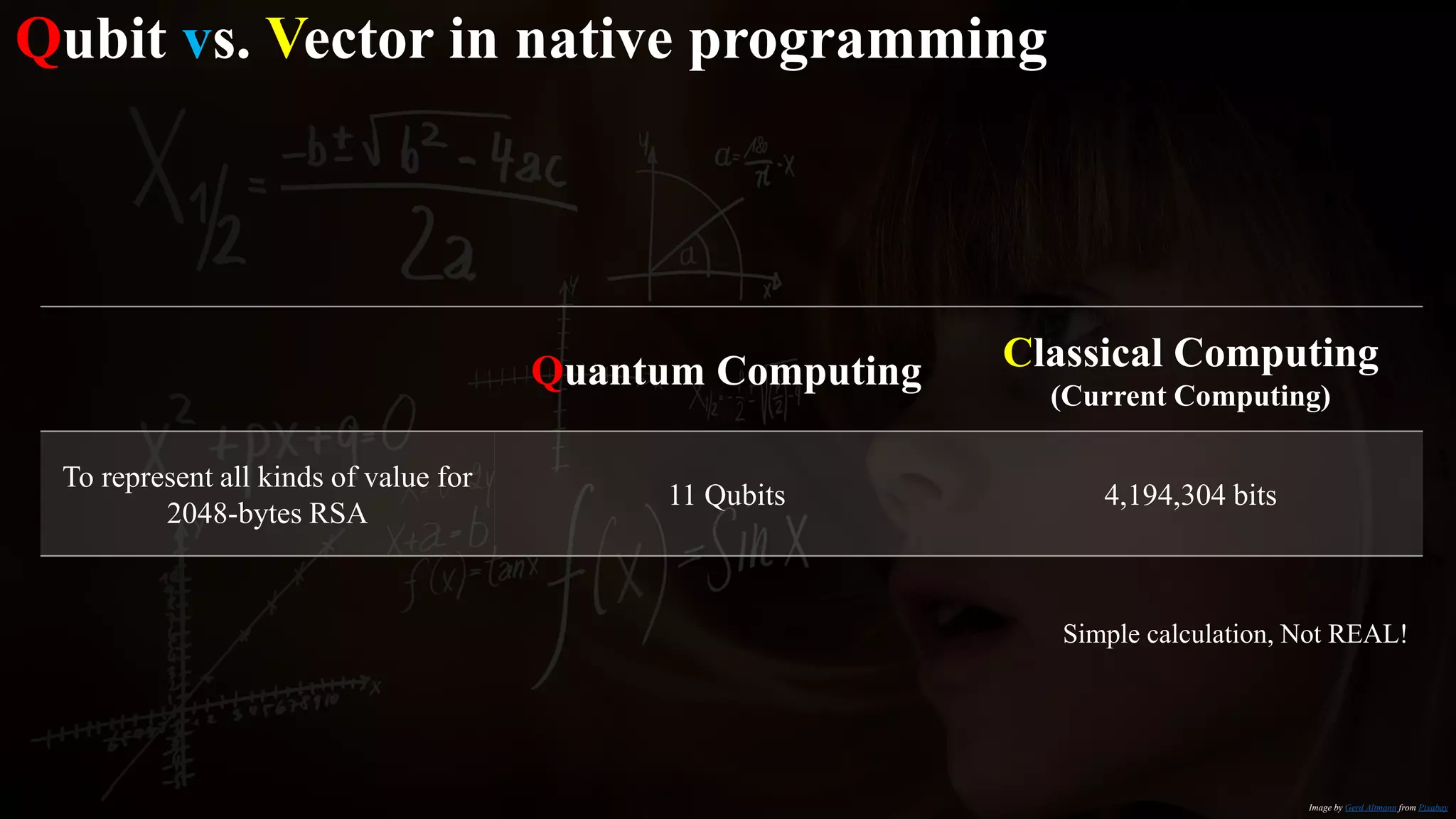
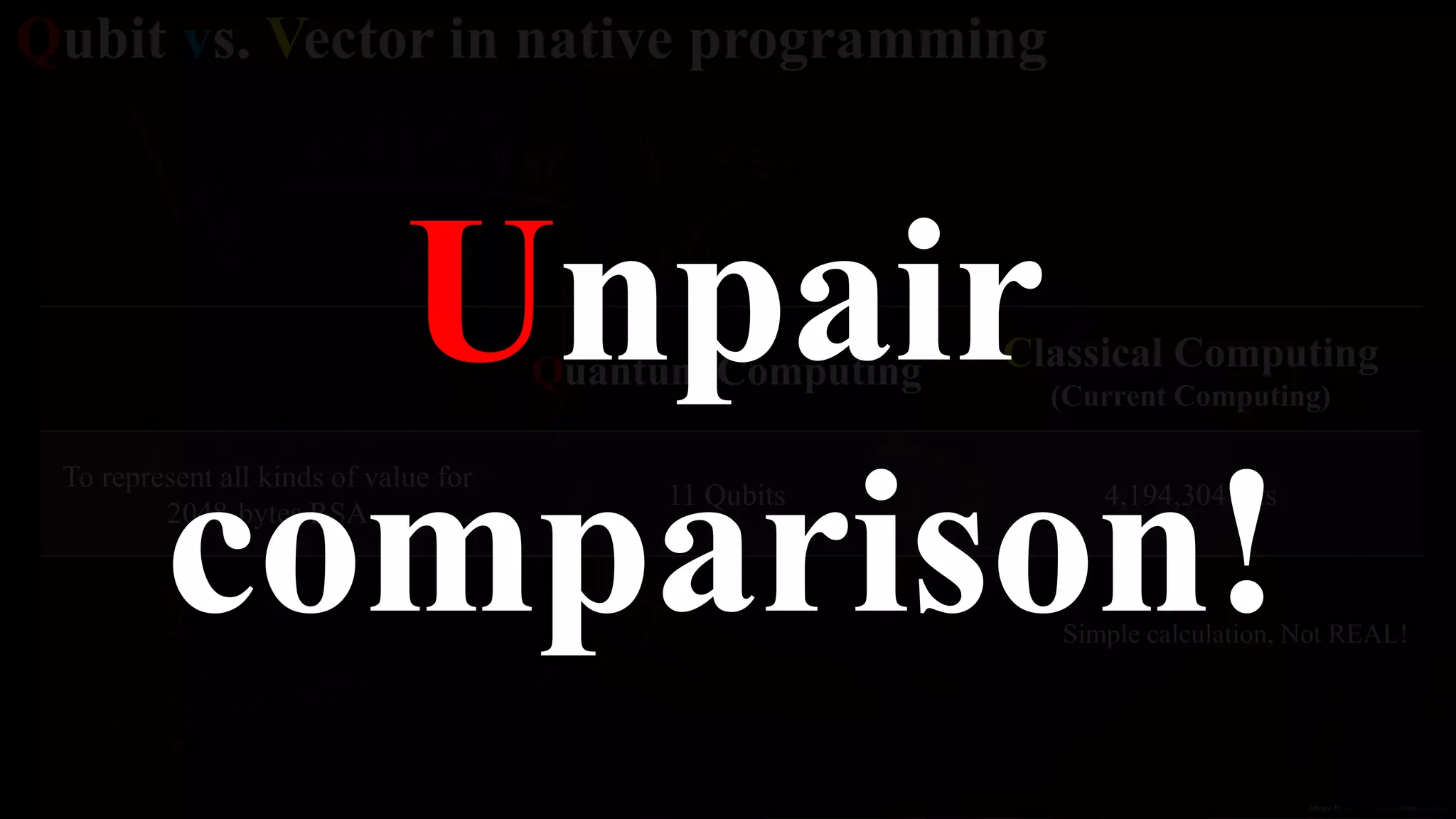
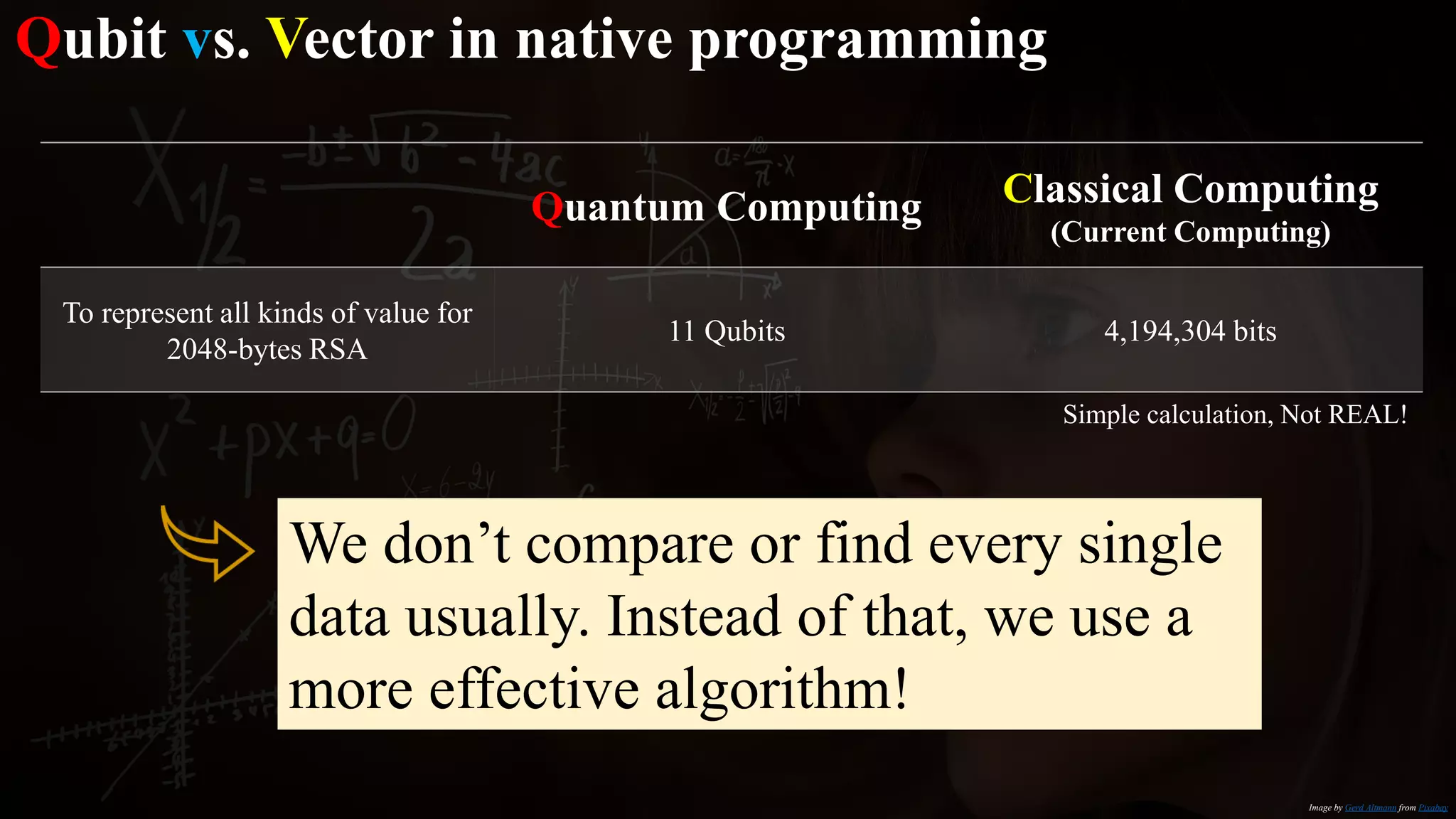
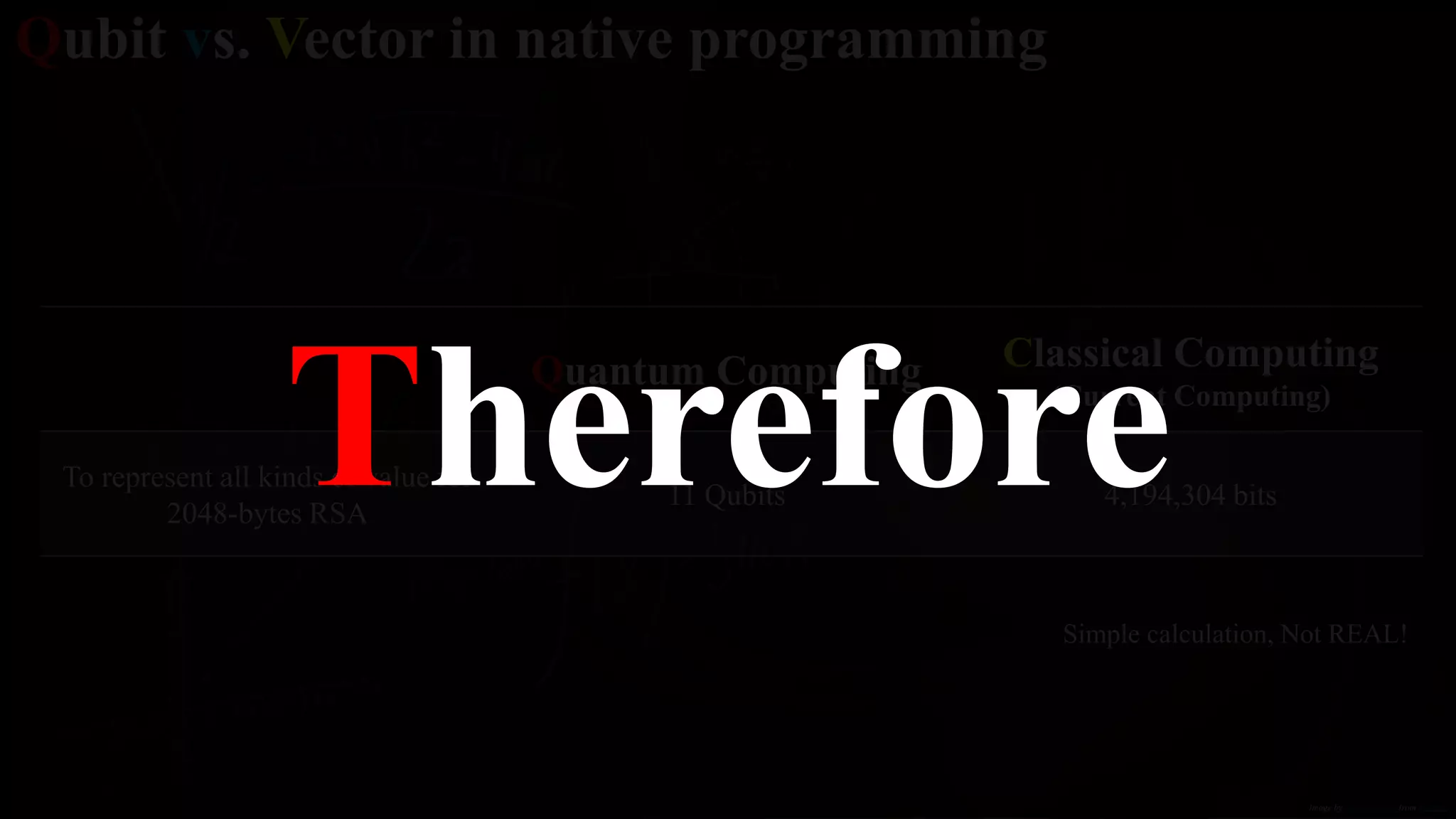
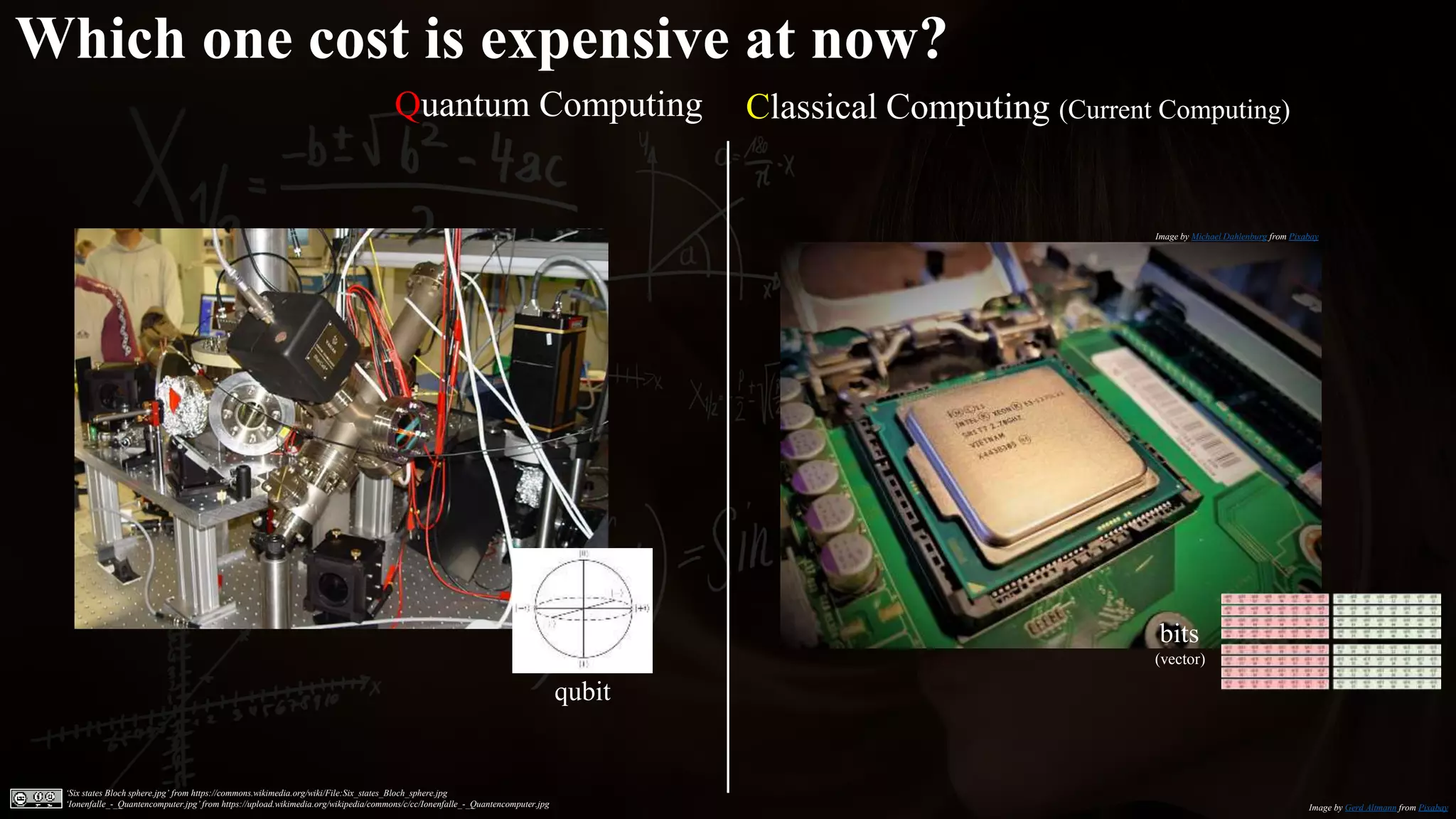
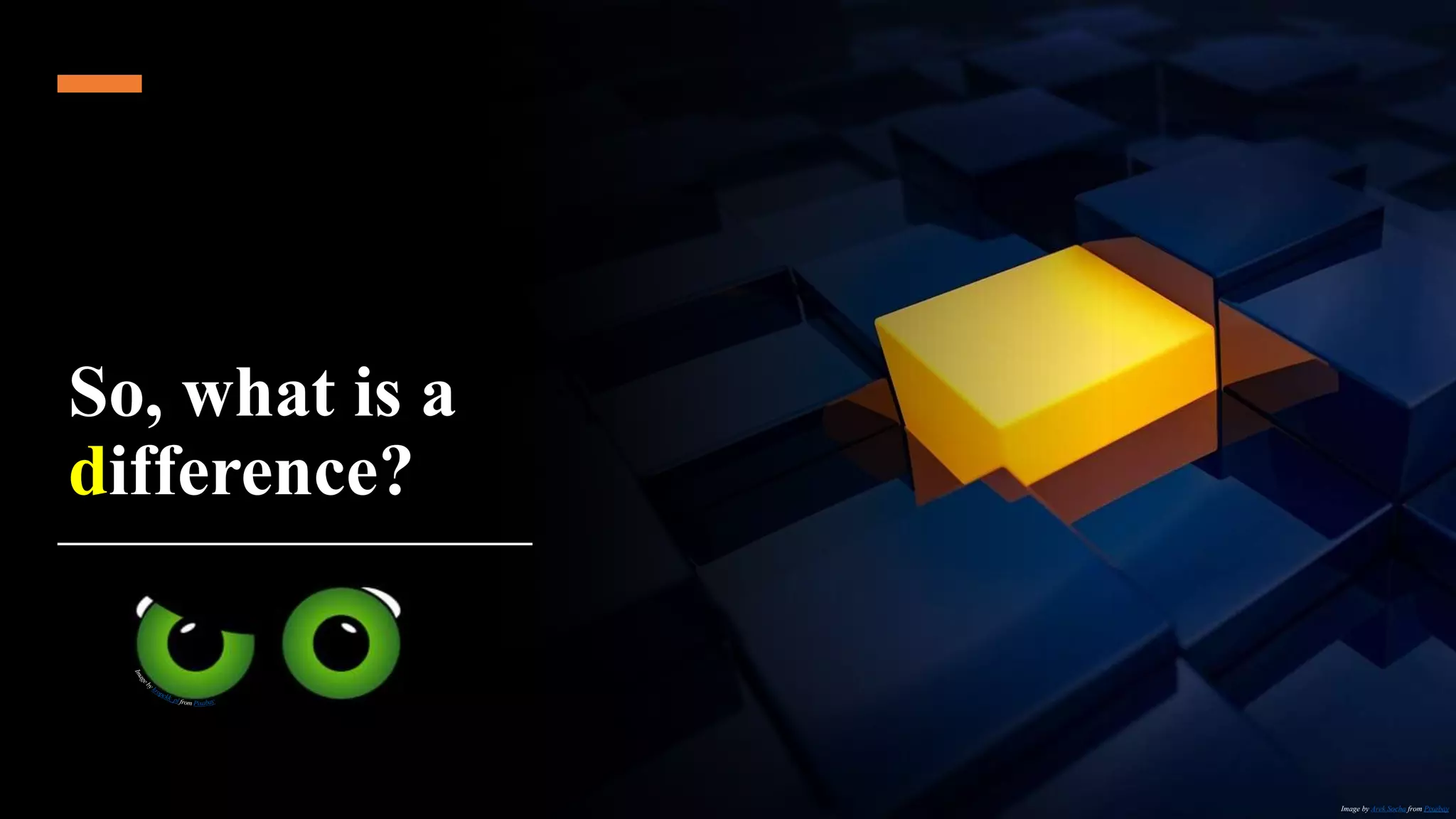
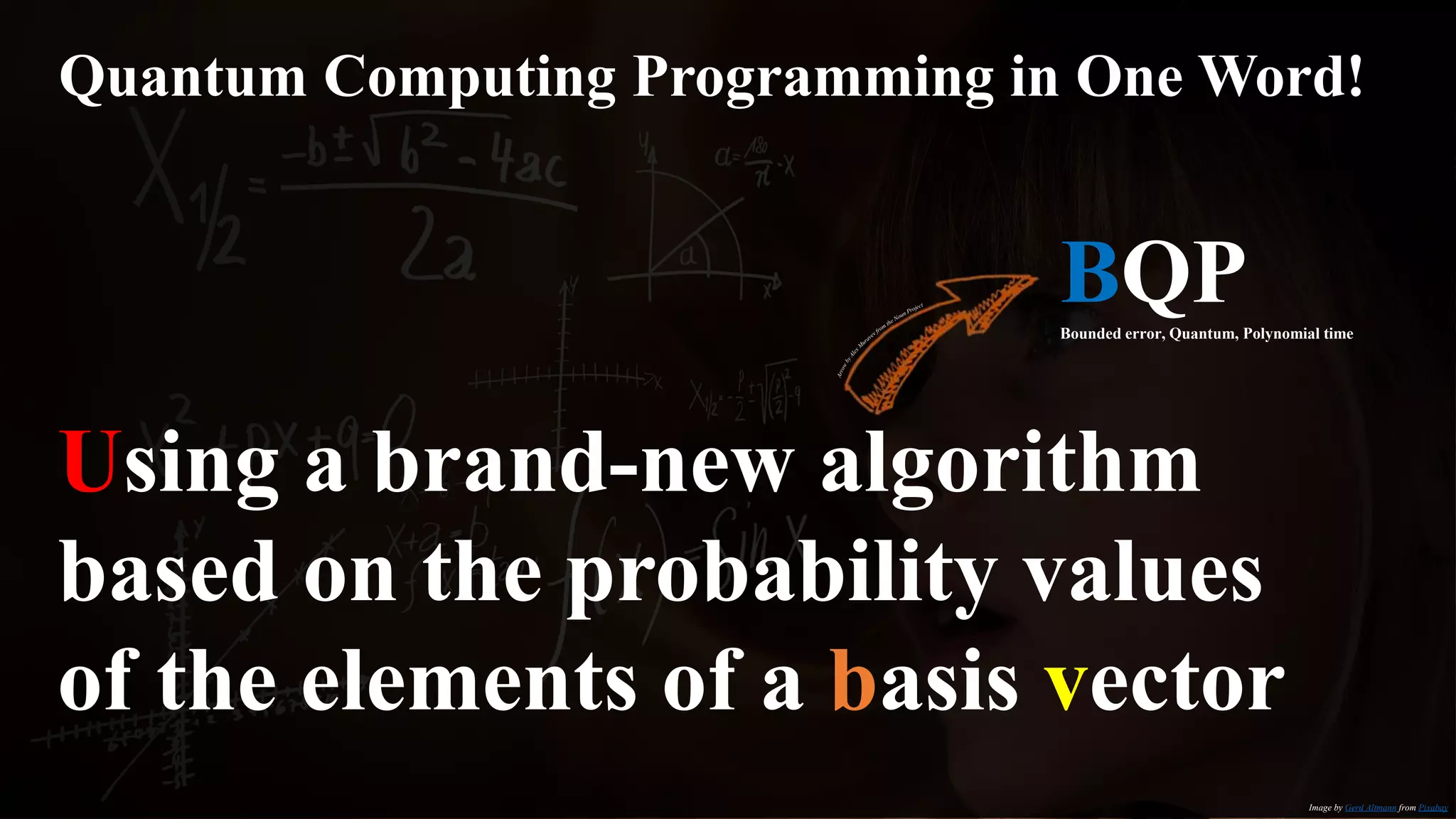
![Quantum Algorithm Image by Gerd Altmann from Pixabay Shor’s algorithm S. J. Lomonaco, “A LECTURE ON SHOR’S QUANTUM FACTORING ALGORITHM VERSION 1.1,” undefined, 2000, Accessed: Jan. 23, 2021. [Online]. Available: https://www.semanticscholar.org/paper/A-LECTURE-ON-SHOR’S-QUANTUM-FACTORING-ALGORITHM-1.1-Lomonaco/bbe14fd73a8cf5795a4a50a1a71ff31bb7e0eca3. Quantum Computation Classical Computation Step 1. To choose positive integer m. ‘gcd (m,N) ≠ 1’ m is non-trivial factor of N. ‘gcd (m,N) = 1’ move to Step 2. Step 2. Use a QFT to find period P of ‘ma mod N’ Step 3. If P is an odd then move to Step 1. If is not move to Step 4. Step 4. ‘mP/2 + 1 = 0 mod N’ move to Step 1. If not move to Step 5. Step 5. ‘d = gcd(N, mP/2 - 1)’ is a non-trivial factor of N.](https://image.slidesharecdn.com/qcforappprogrammer-210212161029/75/Quantum-Computing-for-app-programmer-40-2048.jpg)
![Quantum Computer and Classical Computer Image by 3mikey5000 from Pixabay F. Ablayev et al., “Model of a Programmable Quantum Processing Device,” Dec. 2016, Accessed: Jan. 23, 2021. [Online]. Available: https://arxiv.org/abs/1612.06322. Classical Controller Quantum Processing Unit Init Measure Quantum Memory Quantum Transistor Step 2 Step 1, 3~5](https://image.slidesharecdn.com/qcforappprogrammer-210212161029/75/Quantum-Computing-for-app-programmer-41-2048.jpg)
